Feed aggregator
Monday Musings: A Little Piece of Italy
Last April, after a grief-filled winter, and a previous fall that was more difficult than I could possibly describe, Nancy and I went to Italy for three weeks — a long-delayed trip that had once been intended as a celebration of our 60th birthdays, both of which were more than a year passed by then.
While in Italy, we spent four lovely days in the ridiculously picturesque city of Venice, and while there, we took a day to visit Murano, a portion of the city that is renowned for its glass factories. It is, if you are not familiar with the history of glass-making in Venice, home to the Murano Glassworks, one of the most renowned glass producers in the world. It is also a gorgeous part of the city. We had a great time there, walking around, looking in shops, getting some food, enjoying the play of color and light on the waterways and old buildings. We watched a glass-blowing exhibition at the Murano factory, and bought many gifts for friends and family back home, as well as for Nancy.
 While walking around, searching for a small souvenir of my own, I stopped in at a modest shop on a square, and found, among other things, several small squares of glass in which were embedded finely-wrought images of bare trees. I was captivated and started up a halting conversation with the shop’s owner, who spoke only a bit more English than I did Italian. We managed to communicate, though, and had a very nice exchange. The works in question, it turned out, had been done by the man’s father. He shaped the trees out of strands of steel wool and then placed them in small molds which he filled with melted glass. Each image came out slightly differently. All of them were delicate and beautiful and utterly unlike anything else I had seen in Venice (or anywhere else, for that matter).
While walking around, searching for a small souvenir of my own, I stopped in at a modest shop on a square, and found, among other things, several small squares of glass in which were embedded finely-wrought images of bare trees. I was captivated and started up a halting conversation with the shop’s owner, who spoke only a bit more English than I did Italian. We managed to communicate, though, and had a very nice exchange. The works in question, it turned out, had been done by the man’s father. He shaped the trees out of strands of steel wool and then placed them in small molds which he filled with melted glass. Each image came out slightly differently. All of them were delicate and beautiful and utterly unlike anything else I had seen in Venice (or anywhere else, for that matter).
I bought the one you see in the photo here. It is small — only 2 1/2 inches by 2 inches — and it is signed — etched, actually — by the artist. I don’t recall what I paid for it. Honestly, I don’t care. I love it. The man wrapped it up in tissue paper, took my payment, and I left his shop, likely never to see him again.
I kept it wrapped up even after we returned to the States. My plan was to open it once we were in our new house, which is what I did. It now sits in my office window, catching the late afternoon sun. And it reminds me of so much. That trip to Italy, which marked the beginning of my personal recovery from the trauma of losing Alex. That day in Venice, which was gloriously fun. The conversation with the kind shopkeeper, whose love for and pride in his father was palpable throughout our exchange. More, that little glass piece is an image of winter, and it sparkles like a gem when the sun hits it. It reminds me that even after a long cold winter, a time of grief and pain, there is always new life and the joy of a new spring.

A cliché, to be sure. But as with so many clichés, it’s rooted in truth.
That little tree — the simplicity of steel wool preserved in glass — brings me joy and comfort all out of proportion to its size and cost. I think Alex would love it, too.
When we were getting ready to move, Nancy and I unloaded a lot of stuff. We talked often of the joy we derived from “lightening our lives,” culling from our belongings items we no longer needed or wanted. And I am so glad to have done that work. But I will admit that I still get great pleasure out of many of things we kept, including little tchotchkes (Yiddish for “trinkets” or “little nothings”) like this one.
Wishing you a wonderful week.
Monday Musings: A Little Piece of Italy
Last April, after a grief-filled winter, and a previous fall that was more difficult than I could possibly describe, Nancy and I went to Italy for three weeks — a long-delayed trip that had once been intended as a celebration of our 60th birthdays, both of which were more than a year passed by then.
While in Italy, we spent four lovely days in the ridiculously picturesque city of Venice, and while there, we took a day to visit Murano, a portion of the city that is renowned for its glass factories. It is, if you are not familiar with the history of glass-making in Venice, home to the Murano Glassworks, one of the most renowned glass producers in the world. It is also a gorgeous part of the city. We had a great time there, walking around, looking in shops, getting some food, enjoying the play of color and light on the waterways and old buildings. We watched a glass-blowing exhibition at the Murano factory, and bought many gifts for friends and family back home, as well as for Nancy.
While walking around, searching for a small souvenir of my own, I stopped in at a modest shop on a square, and found, among other things, several small squares of glass in which were embedded finely-wrought images of bare trees. I was captivated and started up a halting conversation with the shop’s owner, who spoke only a bit more English than I did Italian. We managed to communicate, though, and had a very nice exchange. The works in question, it turned out, had been done by the man’s father. He shaped the trees out of strands of steel wool and then placed them in small molds which he filled with melted glass. Each image came out slightly differently. All of them were delicate and beautiful and utterly unlike anything else I had seen in Venice (or anywhere else, for that matter).
I bought the one you see in the photo here. It is small — only 2 1/2 inches by 2 inches — and it is signed — etched, actually — by the artist. I don’t recall what I paid for it. Honestly, I don’t care. I love it. The man wrapped it up in tissue paper, took my payment, and I left his shop, likely never to see him again.
 I kept it wrapped up even after we returned to the States. My plan was to open it once we were in our new house, which is what I did. It now sits in my office window, catching the late afternoon sun. And it reminds me of so much. That trip to Italy, which marked the beginning of my personal recovery from the trauma of losing Alex. That day in Venice, which was gloriously fun. The conversation with the kind shopkeeper, whose love for and pride in his father was palpable throughout our exchange. More, that little glass piece is an image of winter, and it sparkles like a gem when the sun hits it. It reminds me that even after a long cold winter, a time of grief and pain, there is always new life and the joy of a new spring.
I kept it wrapped up even after we returned to the States. My plan was to open it once we were in our new house, which is what I did. It now sits in my office window, catching the late afternoon sun. And it reminds me of so much. That trip to Italy, which marked the beginning of my personal recovery from the trauma of losing Alex. That day in Venice, which was gloriously fun. The conversation with the kind shopkeeper, whose love for and pride in his father was palpable throughout our exchange. More, that little glass piece is an image of winter, and it sparkles like a gem when the sun hits it. It reminds me that even after a long cold winter, a time of grief and pain, there is always new life and the joy of a new spring.
 A cliché, to be sure. But as with so many clichés, it’s rooted in truth.
A cliché, to be sure. But as with so many clichés, it’s rooted in truth.
That little tree — the simplicity of steel wool preserved in glass — brings me joy and comfort all out of proportion to its size and cost. I think Alex would love it, too.
When we were getting ready to move, Nancy and I unloaded a lot of stuff. We talked often of the joy we derived from “lightening our lives,” culling from our belongings items we no longer needed or wanted. And I am so glad to have done that work. But I will admit that I still get great pleasure out of many of things we kept, including little tchotchkes (Yiddish for “trinkets” or “little nothings”) like this one.
Wishing you a wonderful week.
Hugh and the Distressing Lack of Videos

It’s Reader Question Monday. We might have to do a Reader Question Wednesday as well, as we received many questions about Amazon and digital ownership.
You mentioned in the introduction that you usually publish a scene but this time would publish a full chapter. It made me wonder if, when planning a book, you explicitly plan for two scenes to a chapter, which seems to be your usual (though not always). Is it a thought out plan or just your natural writing rhythm?
We don’t plan a book in chapters, not do we stick to any rules regarding how long the chapters are or how many scenes they have. Chapters happen because it feels right to have a natural break in the narrative. We have a rough road map of where we are going, but when it comes to actual writing, we plot in chunks.
For example, the current Hugh chunk is
Aberdine sends people -> Hugh goes to Aberdine – > confrontation with the mercenaries.
Originally, we planned on summarizing the Aberdine delegation arrival and kind of stuffing it as a mini-flashback into the scene that opened with Hugh riding toward Aberdine. There didn’t seem like there would be enough happening during that initial meeting to warrant its own scene.
However, as we started writing it and unpacking all of the emotional undercurrents, it grew into its own chapter. This is the joy of writing: the unexpected discoveries.
Why don’t you let people point out the typos?
Because the comment section degenerates into a nitpicking session and then different writing experts start fighting with each other. This is the first draft; it is fragile and unpolished, and too much criticism will kill it. You are seeing it as it is, with all of its flaws. If you want the cleaned up version, you will have to wait until release. Muhahahaha!
So Hugh 2 is being rewritten? In 2020 it was announced that the release was on hold because it was a dark story and the world was in a dark place. I thought that meant it was done. It’s been five years, so when I look around to see if I missed anything it sounds like it may be in progress?
No. Hugh was never written, but we knew what we needed to write and at that particular time, we didn’t have emotional fortitude to do it. Writing books requires a huge emotional investment, because we, as writers, live through he character emotions so we can accurately portray them on the page.
Life interferes as well. Sometimes stuff happens to knock you off your writing rails. Yesterday we didn’t get any writing done because we email the comments from the site to ourselves and Mod R for moderation, and we have to use SMTP for that, because WordPress just kind of quit sending comments to us. For no apparent reason the SMTP callback is failing.

Despite 5 hours with host support chat, it is not fixed. They tossed me back to the SMTP plugin support, which has yet to respond. I wasn’t in the mood to write witty banter after that. I was just tired and needed some tea.
Why don’t you and Gordon make more videos where you talk about writing?
This is one is a little out of the left field. I’m guessing this must’ve come about because of the keyboard typing video. Being a writer and being an influencer are two different things. Writers primarily market their books by doing yet more writing, and influencers primarily provide entertainment while also marketing a product either directly or through ads. Some people admirably combine both.
We are not that great on camera, and we are not very entertaining. We would make terrible influencers. Neither of us has those particular skills and talents. Thankfully, we are not celebrities by any measure, so that is not required of us.
Our posts are mostly about what we do: things we write, things we cook, build, crochet, and so on. It’s less about being a writer and more about the work itself or the process. We try to maintain that boundary between product and person.
Basically, you get enough of me carrying on on the blog. You don’t need us on your YouTube.
See you on Wednesday!
The post Hugh and the Distressing Lack of Videos first appeared on ILONA ANDREWS.
Spotlight on “The Unwanted” by Boris Fishman
The Unwanted is a stunning story of what the most powerless among us will do…
The post Spotlight on “The Unwanted” by Boris Fishman appeared first on LitStack.
Monday Meows
Oh, hell, is it Monday again? I’ve got nothing.
Gzzznorkzzzzzzzzz
I vote we bag it for the week.
I have a tail!
Guns or Butter? Total War: Warhammer II
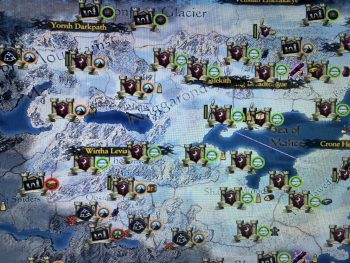 I came to Total War way back when, through TW: Rome. Arriving in 2004, it was the third game in the TW series, after Shogun, and Medieval. I liked it, though I wasn’t addicted – as I was to many games back then. But it was fun marshaling armies, and then marching them out to crush your enemies. I talked about it a little bit a few weeks ago in my RTS overview (man, Myth: The Fallen Lords was such a great game!).
I came to Total War way back when, through TW: Rome. Arriving in 2004, it was the third game in the TW series, after Shogun, and Medieval. I liked it, though I wasn’t addicted – as I was to many games back then. But it was fun marshaling armies, and then marching them out to crush your enemies. I talked about it a little bit a few weeks ago in my RTS overview (man, Myth: The Fallen Lords was such a great game!).
Sort of the “What is best in life?” response from the first Conan movie with Ah-nuld:
“To crush your enemies, see them driven before you, and to hear the lamentations of their women.”
There have been over a dozen incarnations, with the Egyptian-themed Pharaoh just dropping in 2023. What I’d LOOOOOVE, is for them to get the license from the Tolkien Estate and do TW: Middle Earth. I enjoyed Battle for Middle Earth I (never played II). But even a decently-done TW: Middle Earth would be FANTASTIC!!!!
Anywhoo. I’ve never done the Warhammer thing, but TW: Warhammer I came out in 2016. And TW: Warhammer II followed the next year. WH II has become the rabbit hole I periodically jump down. This game is — as my buddy Tony dubbed Diablo II long ago — electronic crack.
If you have WH I, you can use those factions/lords some in WH II. But you don’t need them at all. And while the base game is more than enough, part of the TW fun is buying the DLC – they add heroes, factions, and even a few campaigns. I don’t have WH III, but I the model is the same.
I have all the DLC for both WH I, and II. They are frequently 50% off+ on sale. Total War keeps ‘old’ product at original prices. It’s an annoying business model, and they do a boatload of DLC. But the base games have more than enough content. I just like the extra stuff to check out. And you don’t have to buy it, off course.
The Game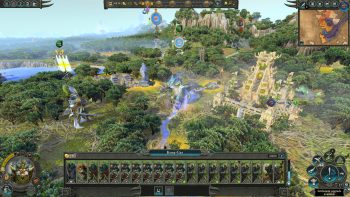 Some basics about Total War – at least, the Warhammer II version. The principles of the series are generally the same. You know what you’re getting, but the engine has evolved over the years. Warhammer II is pretty similar to I. I have not played III yet. I tried to go back to Rome Remastered earlier this year, and that old engine just didn’t work for me anymore.
Some basics about Total War – at least, the Warhammer II version. The principles of the series are generally the same. You know what you’re getting, but the engine has evolved over the years. Warhammer II is pretty similar to I. I have not played III yet. I tried to go back to Rome Remastered earlier this year, and that old engine just didn’t work for me anymore.
The general concept is you take charge of a faction (Elves, dwarves, vampire pirates, etc. In other games it’s Roman families, or medieval countries. You get it).
You build up settlements, and armies on a unit basis, for your faction. You can choose to fight the battles yourself (usually advantageous in outcome) or use auto-resolve. I find the battles time-consuming and not that much fun, so I auto-resolve. The benefits of auto-resolve seem to be reduced from winning the actual fights yourself, though.
Terrain matters in battles, and also on the global map. Dwarven settlements thrive in mountain regions. The vampire lords corrupt the land, making it less/unsuitable for some factions. The lizardmen are primarily in the jungles. So, the faction you choose often impacts what part of the world you start in, and where you choose to expand to.
You attack other armies, and settlements, or colonize ruined ones. You build them up, gaining advantages if you control all the settlements in a single province. You have to balance chasing quests, conquering settlements, and being strong enough on defense to protect what you already have. Random wandering warherds, or rogue armies (frigging pirates) can seriously blow up your plans.
You can form military alliances (as can your enemies), and when you’re strong enough, you can make a confederation with a same-race faction: absorbing all their assets – and their financial obligations!
I just keep playing and trying to expand without a debacle happening. The first ten to fifteen turns usually indicate whether I’m gonna be able to make a go of it with this faction.
Two Game OptionsThe base campaign is Battle for the Vortex. There are game-given quests, and faction quests as well. You try to build up your settlements and armies, eliminate enemies, and accomplish the various quests. I’ve never made it to the end game. Even on Easy, the computer AI is a pain in the ass. I’ve rarely made it past 100 turns before it got too messed up.
WH II also has a Mortal Empires option. It lets you pick any lord/faction from I or II, and compete against all the other factions. Last one standing wins: No over-arching campaign. I’ve played Mortal Empires a few times, and it’s a neat option, but I prefer playing the official campaign. So….
‘Guns or Butter’‘Guns or butter’ is an old economic model that shows how governments have to choose between spending for defense or domestic uses. TW play is a variation on that which is pretty much the over-arching element of the game.
You can primarily choose to spend gold on military units, or settlement buildings (there can be a couple other options, like temporary enhancements, but you’re mostly putting your gold into your settlements, or your armies).
And your armies (you start with one, but need multiple ones to survive) have upkeep costs. So, you have a one-time cost to add the unit, then an ongoing cost per turn, to keep it. The bigger your army, and the more advanced the units you use, the greater your upkeep. Which means less gold for your settlement buildings.
Each Province has a capital settlement, with five levels. And except for a couple exceptions, one to three minor settlements, with three levels. You build up your Province Capital, which opens up additional slots for new buildings. There can be a total of ten building slots in a Capital, and there are usually only three additional slots in a minor settlement.
Building Categories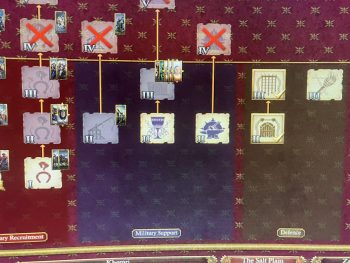 Choosing available options for a small settlement slot
Choosing available options for a small settlement slot
There are different types of ‘chains’ you can pick your settlement upgrades from. I really like this part of game management. And it’s essentially guns or butter. They have different classifications for different factions, but that’s just wording.
Resources – Available in certain settlements. They provide specific goods, like tradable resources (hides, marble, clay), plaques (related to some faction goals), or other benefits. Most settlements do not have this option, so I often take whatever it is. It’s nice when it’s a gold mine, as that is the best source of gold in the game.
Military Recruitment – These produce basic, and advanced, military units.
Basic buildings usually only have three levels, and you can start them when your Province Capital is only first level. They usually offer some other minor benefits, but this is where the meat shields and lower-level units come from. You build your starter armies here.
Advanced buildings usually go up to levels four or five, and provide elite units and enhancements. You need advanced units to get through the middle, and end, games. Purely gun stuff here.
Military Support – These buildings support your armies, lords (Each army is led by a lord), and heroes (a hero is a unique unit that can perform helpful actions and also provides benefits), and settlements. They might make recruitment costs less, reduce your casualty replenishment rates, or let you recruit infantry units with shields. More guns.
Defense – This a limited category, usually letting you add walls to your settlements, or some other defensive improvement for it. I always add walls to smaller settlements, but otherwise, this is my least-used category. As the title implies, this is a defensive category and kind of feels like a mix of guns and butter.
Infrastructure – Here you really get into the guns or butter dichotomy. There’s a wide range of options. Your main gold-making options are here. Also, you can focus on growth (how fast your settlements expand), and public order (if public order gets to-100, you have to put down a rebellion).
There are a lot of options here. Since you only get three additional slots in a smaller settlements, the choices are important. I do try to put up walls in small ones, so, with the Capital building, you only have two free slots. And you’re really choosing between guns and butter.
Misc. -Some settlements have Ports, and some have Landmarks. Ports generate gold and have their own chain. Landmarks are unique to a specific settlement and offer some benefit often worth taking. Even if it’s just a one-level use of a slot.
Choosing Your BuildingThe game randomly has factions declare war on you. And you can also end up at war with other factions through diplomacy options (that’s part of a follow-up post). You need to build up your first army in a hurry (you start the game with a lord and a small army of five-eight units, usually). Some faction is already pissed at you.
It’s tempting to use an early slot to pick a chain with a new military unit. You can get a more diverse, more effective, army, right out of the gate. Guns over butter.
But you gotta pay for all these troop units, and the constantly being constructed new buildings. So, taking that industrial building with a big per turn revenue, is tempting. The gold mine is a no brainer. In a small settlement (remember, only three slots in addition to the Capital), I almost always choose the max revenue building first. I need that stream started to build that first army.
The third (and last) slot usually goes to walls, which help with defense if you end up under siege. It’s the second slot that lets me shade towards guns or butter. For purposes of this discussion, growth and other things that primarily affect the settlement, or my revenue stream, are butter.
Since the capitals have eight to ten slots, and they go up to level five, I tend to use them for the advanced military buildings, to maximize my firepower. Some support, and non-military buildings go up to level five, so you have to factor that in as well. And walls never hurt.
TechnologiesFactions have unique Technology trees. Some are easier to develop than others. But they also reflect the guns or butter dilemma. Especially early on, you can choose technologies (which take multiple terms to develop) to enhance troop unit strength. And also to decrease recruiting costs.
Alternately, technologies that enhance your revenue stream can be vital in providing gold to maintain your growing army. Or building up your settlements.
And any time you can increase your growth or public order, you need to weigh those as immediate needs against those other areas. Butter.
Army Units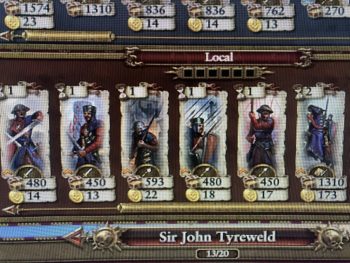 Basic units (like spearmen, or archers) cost a lot less to hire recruit and maintain, than ones such as knights, war eagles, or catapults. The stronger your army, the more it’s gonna cost you. And by mid-game, your main armies had better not still include a bunch of grunts; even if they have leveled up. You needs some higher power units.
Basic units (like spearmen, or archers) cost a lot less to hire recruit and maintain, than ones such as knights, war eagles, or catapults. The stronger your army, the more it’s gonna cost you. And by mid-game, your main armies had better not still include a bunch of grunts; even if they have leveled up. You needs some higher power units.
Armies are capped at a total of 20 units. Do you want a second full-size army? Or two medium-sized ones? Recruit a lord and build a 6 unit army to provide a military presence in a province with falling public order? All those units have an ongoing cost every turn…
You have multiple layers of guns or butter to decide upon. Bad things start to happen if your revenue stream goes negative. And enemies can raid your province, decreasing revenue. Or sack, burn to the ground, or even take over your settlements. And those things can hit your stream.
So, you need to have armies ready not only for attack, but defense. Again – that takes gold.
Wanna hire more lords or heroes? Cha-ching!
In the pic to the right, recruiting a knight will cost about three times as much as recruiting the spearman at arms next to him. But maintaining him each turn will cost ten times more.
So…Budgeting is the allocation of resources among multiple activities. Total War is strategic and tactical game of allocating resources. And basically, you decided whether to spend your gold on guns or butter. And you need the butter to make more gold. To pay for the guns.
I know folks who like playing out the battles. I have fought my share over the years, and I get it. But the faction management part of the game is what keeps me coming back. Guns or butter.
Crusader KingsA quick mention of another game.
For a kingdom management-and-war type of game, the Crusader Kings line (three so far) looks to be the standard. I have tried the first game a few times, and it’s got a MASSIVE learning curve. I think it’s manageable, I just haven’t been motivated to master the basics enough to continue on. But it does look like an awful lot of fun if you figure it out.
Next TimeThere will be a follow-up Total War post, in which I’m going to talk about how I recently had two of my most successful games by applying principles contained in George Washington’s Farewell Address. That was actually the original intent of this post, but I really enjoyed the guns or butter discussion.
Other Video Gaming Posts
RTS’ and Myth: Fallen Lords
Mount and Blade – Part One
Mount and Blade – Part Two
Steamed: What I’ve Been Playing (December, 2023)
Steamed: What I’ve Been Playing (October, 2022)
Fortnite (one of several mentions)

Bob Byrne’s ‘A (Black) Gat in the Hand’ made its Black Gate debut in 2018 and has returned every summer since.
His ‘The Public Life of Sherlock Holmes’ column ran every Monday morning at Black Gate from March, 2014 through March, 2017. And he irregularly posts on Rex Stout’s gargantuan detective in ‘Nero Wolfe’s Brownstone.’ He is a member of the Praed Street Irregulars, founded www.SolarPons.com (the only website dedicated to the ‘Sherlock Holmes of Praed Street’).
He organized Black Gate’s award-nominated ‘Discovering Robert E. Howard’ series, as well as the award-winning ‘Hither Came Conan’ series. Which is now part of THE Definitive guide to Conan. He also organized 2023’s ‘Talking Tolkien.’
He has contributed stories to The MX Book of New Sherlock Holmes Stories — Parts III, IV, V, VI, XXI, and XXXIII.
He has written introductions for Steeger Books, and appeared in several magazines, including Black Mask, Sherlock Holmes Mystery Magazine, The Strand Magazine, and Sherlock Magazine.
The Gorey Century
Yesterday was the 100th birthday of Edward Gorey, one of the most unique, unclassifiable artists that this country has ever produced. Though he died in 2000, he has a continuing cultural presence; he certainly lives on in my life and in the lives of a great many people.
Back in the incumbency of Jimmy Carter, when I was studying theater and living in the dorms of California State University Long Beach, one year I had a roommate named Scott. Scott didn’t fit into our tight-knit little community very well, and while I’ve always prided myself on my ability to get along with everyone, I didn’t get along very well with him. We had a bumpy year together, but I will always be glad that we were roommates, because Scott introduced me to the work of Edward Gorey, and that was a priceless gift that I can never repay him for.
Edward Gorey was a man of many talents — He did scenic and costume design for the stage, winning a Tony Award in 1978 for his costume designs for Dracula (his set design for that production was also nominated) and several of his stories are about ballet, which was one of his supreme passions. Additionally, he did highly individual book covers; for several years he did them for Anchor Paperbacks (including, among many others, editions of H.G. Wells’s The War of the Worlds, Franz Kafka’s Amerika, and T.S. Eliot’s Old Possum’s Book of Practical Cats), which are highly prized today simply for their Gorey covers. He also edited and illustrated a collection of classic ghost stories (1959’s Edward Gorey’s Haunted Looking-Glass) and did covers and illustrations for several of the supernatural mysteries of John Bellairs.
Beginning in the mid-1950’s, Gorey wrote and illustrated his own very short books, and these are the works that his fame mostly rests on. (Many were published under absurdly comical names that are anagrams of his own, like Ogdred Weary or Mrs. Regera Dowdy.) Visually, they are almost always set in the Victorian or Edwardian era (the closest to our own time that I can ever remember him coming was the 1920’s) and are full of bizarre, grotesque, violent, comic, cryptic, and occasionally supernatural incidents, often involving children; in fact, they are usually “children’s books” in form if not in content. The original small hardcover volumes are hard to come by and are pricey when you can find them, but there are four large omnibus volumes, each collecting a dozen or more of the short works — Amphigorey (1972), Amphigorey Too (1975), Amphigorey Also (1983), and Amphigorey Again (2006).
The first thing of Gorey’s that I ever read was “The Hapless Child”, which chronicles the travails of a lovely little girl named Charlotte Sophia. When the story begins, she’s safely ensconced in the bosom of her loving family (“Her parents were kind and well-to-do.”) Then her father, a military man, is reported killed in a native uprising and her grieving mother wastes away and dies, leaving the girl in the cold, utilitarian hands of the family lawyer, who loses no time in sending her to a boarding school where students and staff range from the merely unsympathetic to the positively sadistic. Things rapidly go from bad to worse, and from this point on, the hapless child is subjected to every horror that could befall a person in the most lurid melodrama, all rendered by Gorey in deadpan language and meticulous pen-and-ink images. Things don’t end well for the poor child, and the first time I read her tale, tears rolled down my face, but they weren’t tears of sadness; I was literally shaking with laughter. (Once the story almost got me thrown out of the college library where I was supposed to be working, when I showed it to a friend who was unacquainted with Gorey. We just couldn’t control ourselves.)
It does no good to try and explain to someone who is appalled by “The Hapless Child” rather than delighted by it that what’s being mocked is not the suffering of an innocent child (there was no Charlotte Sophia — Gorey made her up) but rather the reflexive, self-indulgent sentimentality of a hypocritical era and of readers still shackled to its sticky standards. (And one of the things that makes Gorey a complex artist is that he both recognizes the deficiencies of the Victorian age while at the same time clearly adoring many aspects of it.) Either Gorey lands with you or he doesn’t. For myself, there’s nothing that I like more than a good, Gorey story.
Other Gorey delights are “The Willowdale Handcar”, a series of strange, seemingly disjointed incidents that can, with a little imagination and a close examination of the illustrations, be connected into a coherent (if admittedly dark) narrative. (The story features The Black Doll, a sinister, featureless figure which haunts the edges of many of Gorey’s works.) Gorey could be genuinely frightening, as in “The Insect God”, in which huge insects kidnap children and mercilessly sacrifice them to their chitinous deity, and “The West Wing”, a succession of wordless images showing various rooms in a house that you definitely wouldn’t want to spend any time in. (Gorey could make a patch of peeling wallpaper radiate unease.)
Gorey would sometimes make mere objects his protagonists. In “The Inanimate Tragedy” Pins, Needles, a Glass Marble, a Four-Holed Button, and a Piece of Knotted String become embroiled in conflicts and misunderstandings that end in murder and suicide, if those terms are applicable to the fates suffered by a Half-Inch Thumbtack and a No. 37 Penpoint. Gorey would probably say that the word “tragedy” is no more out of place with junk-drawer contents than it is with the equally mundane and transient objects that we call human beings, and in “The Abandoned Sock” you feel genuine apprehension for the sock who foolishly deserts his mate on the clothesline to go adventuring and gets used for a dust rag, chewed by a dog, caught in a tree, and picked apart by birds to use for their nests until nothing is left of it. Does the sock’s life (which it found “tedious and unpleasant” when it was pinned on the line next to its dull mate) turn out all that differently from our own personal dramas?
One of Gorey’s most famous stories is “The Doubtful Guest”, which sees an odd, penguinish-looking creature attired in tennis shoes and a striped scarf turn up one night at the house of a settled, respectable (boring!) family and proceed to turn things upside down. Without ever uttering a sound, the uninvited visitor eats the plates at dinner, tears chapters out of books, suffers fits of bad temper during which it hides all the bath towels, safeguards objects that it takes a liking to (like expensive pocket watches) by dropping them in a pond, eerily sleepwalks up and down the hallways at night, and otherwise disrupts the placid routines of the baffled family, who have no hope of ever going back to life as it was, because “It came seventeen years ago — and to this day / It has shown no intention of going away.” (Many of Gorey’s stories are written in verse.) You understand the family’s frustration and despair, but you may also feel that a little unpredictability might do them some good. I have my own Doubtful Guest — a college friend of my wife made him for me, and I was delighted to learn that Gorey had several himself, that admirers had made and sent to him. (I have a Black Doll too, but that I had to buy.)
Gorey did several alphabet books; the most well-known (images from it have appeared on calendars, tee-shirts, coffee mugs etc.) is “The Ghastlycrumb Tinies.” Here dewy-eyed tots come to shocking and painful ends (“A is for Amy who fell down the stairs / B is for Basil assaulted by bears / C is for Clara who wasted away / D is for Desmond thrown out of a sleigh). Gorey doesn’t imply that these grim events are the children’s faults, but he doesn’t imply that they aren’t, either.
Gorey wasn’t uplifting or heartwarming, (except perhaps in “The Pious Infant”, the story of Henry Clump, a little boy who is too good to live long, and thank God he doesn’t) but now and then justice is served, as it is in “The Bug Book”, one of the few Gorey stories that’s not in black-and-white. In this tale of collective security and well-earned retribution, a peaceful group of bugs have their happy society wrecked by a new bug in the neighborhood, a big, brutish interloper who, despite their best efforts to be friendly and welcoming, “broke up their parties” and “waylaid them whenever they went visiting.” After a secret meeting in the dead of night, the problem is solved by squashing the obstreperous insect flat with a big rock. His remains are placed in an envelope addressed “To whom it may concern” and a pleasant and lively social life is resumed (in Gorey’s world, clearly the happiest of happy endings).
The great Literary critic Edmund Wilson (he who disparaged detective stories and sneered at Tolkien and Lovecraft) was an early admirer of Gorey; he found the artist’s singular little books pleasingly suggestive and allusive. “I find that I like to return to them,” Wilson said. The critic was wrong about a lot of things, but he was right about Edward Gorey. Over almost a half a century, I too have continued to come back to Gorey’s strange, sinister, darkly comic world. There is truly nowhere else like it.
Edward Gorey, this contradictory man who loved attending classical ballet (he was present for every performance of the New York City Ballet for twenty-five straight years) and watching “trash TV movies on the USA Network” was sui generis, the sort of one-of-a-kind genius who can only be appreciated and enjoyed, never imitated or emulated. The mark he set was too high for anyone else to reach… or maybe it would be more accurate to say that it wasn’t too high, exactly; rather, it was too far off to the side.
Whatever deserted house, sinister garden, enigmatic landscape or dimly-lit stage your eccentric spirit now haunts, Edward Gorey, happy birthday to you. Your ashes may have been scattered to the four winds, but your work goes marching on; I fully expect your macabre miniatures to be around for at least another hundred years.
Thomas Parker is a native Southern Californian and a lifelong science fiction, fantasy, and mystery fan. When not corrupting the next generation as a fourth grade teacher, he collects Roger Corman movies, Silver Age comic books, Ace doubles, and despairing looks from his wife. His last article for us was Reading for the End of the World Redux
Recommended Reading List: September 2024
Yeah, the last list from 2024. Finally. I thought maybe I would just punt this one, but I like sharing what I’ve read that I’ve liked. So I didn’t want to lose all of these to extreme busy-ness. I barely remember September, so I can’t give you lots of comments. I do know that I had almost no sleep, so any reading I got done was stolen from other projects.
I am not going to include the articles here, like I usually do. In the spirit of kicking 2024 to the curb, those are going to be sacrificed. So here are the three books that I loved in September…
September 2024 Balogh, Mary, Always Remember, Berkeley, 2024. Mary Balogh writes in series that focus on a particular family. I liked how this series started, and wrote about it in several of the Recommended Reading Lists. This book, about Ben Ellis, who has a charming daughter and is one of the more interesting characters in the series, is a personal favorite. I felt sad when I finished this one. Balogh had been promising this romance throughout the series, and it was satisfying when she finally got to it.
Balogh, Mary, Always Remember, Berkeley, 2024. Mary Balogh writes in series that focus on a particular family. I liked how this series started, and wrote about it in several of the Recommended Reading Lists. This book, about Ben Ellis, who has a charming daughter and is one of the more interesting characters in the series, is a personal favorite. I felt sad when I finished this one. Balogh had been promising this romance throughout the series, and it was satisfying when she finally got to it.
King, Stephen, “Danny Coughlin’s Bad Dream,” You Like It Darker, Scribner, 2024. This isn’t a short story; it’s a novella. King excels at the novella form. I read the entire short novel in one sitting, uncertain where any of it was going. There’s always an edge in King’s fiction, a feeling that one wrong move and the story will collapse. I felt that here, but the story never made the wrong move. It’s powerful and worth the price of the entire collection.
King, Stephen, “On Slide Inn Road,” You Like It Darker, Scribner, 2024. Everyone is fair game in a King story, so I try to avoid some of the ones featuring children. I got sucked into this one right off the bat, though, and read it with one eye closed and my face averted. Memorable, sadly enough.
King, Stephen, “Two Talented Bastids,” You Like It Darker, Scribner, 2024. In the hands of a lesser writer, this story would have been cliche-ridden and hard to read. Here, it’s touching and one of my favorites in the collection. I’m not going to say anything else for fear of spoiling the story for you.
King, Stephen, You Like It Darker, Scribner, 2024. I think I like Stephen King’s short stories the best of all his works, and I’m a fan. I like almost everything he does. (The Dark Tower series doesn’t work for me, and lately he’s ventured into Covid territory, which I’m not ready for, but mostly, I’ll follow him anywhere.) This entire book is wonderful. I’ve highlighted some favorite stories here, but I can recommend the entire volume as well.
 Roberts, Nora, Mind Games, St. Martin’s Press, 2024. I’ve been very disappointed with Nora Robert’s standalone titles the past few years, so I bought this one with trepidation. I felt like she hadn’t been challenging herself in some of the previous books or she lost interest in them or something. They just didn’t have her usual vibrancy. This one does. It was a rich book, difficult to put down, even though I had to because of everything else going on. The perfect escape that makes me look forward to her next…just like it should.
Roberts, Nora, Mind Games, St. Martin’s Press, 2024. I’ve been very disappointed with Nora Robert’s standalone titles the past few years, so I bought this one with trepidation. I felt like she hadn’t been challenging herself in some of the previous books or she lost interest in them or something. They just didn’t have her usual vibrancy. This one does. It was a rich book, difficult to put down, even though I had to because of everything else going on. The perfect escape that makes me look forward to her next…just like it should.
Heir of Light, full cover
Chasing the Power to Save in “Telephone” by Percival Everett
Telephone is a deeply affecting story about the lengths to which loss and grief will…
The post Chasing the Power to Save in “Telephone” by Percival Everett appeared first on LitStack.
There, Wolves: Part I
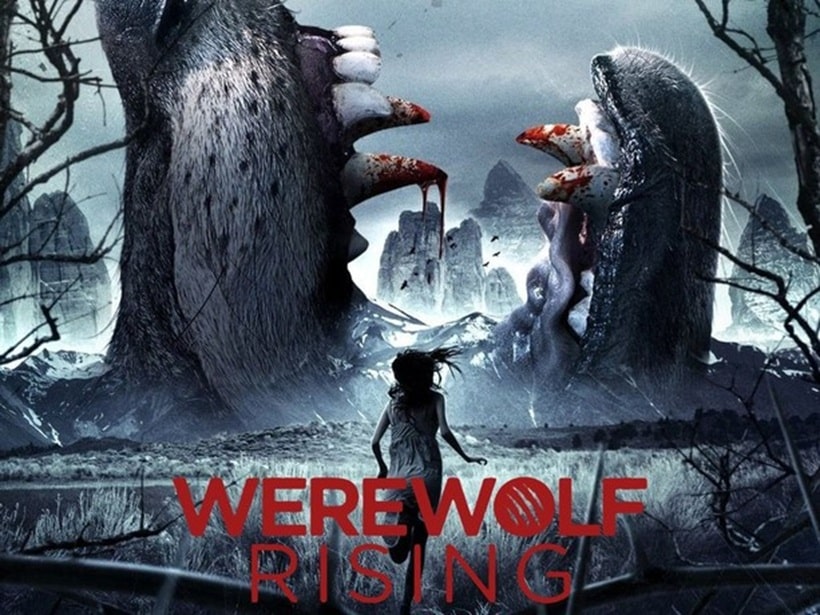 Werewolf Rising (RLJ Entertainment, October 14, 2014)
Werewolf Rising (RLJ Entertainment, October 14, 2014)
A 20 film marathon of werewolf movies I’ve never seen before.
As usual, the films must be free to stream.
I’ve got a bad feeling about this.
Werewolf Rising (2014) YouTubeMan or beast? It looks more like a hairy extra from The Hobbit.
Howling’ good time? Nope. We are off to a rip-roaring start with this dull effort shot entirely in Arkansas, if that floats your boat.
A paper thin plot is played out in a forest with a single digit, lacklustre cast and the whole shebang is shot in glorious murky-vision. The only redeeming feature might have been the beast(s), but they are rubbish.
Oh god. What have I started?
3/10
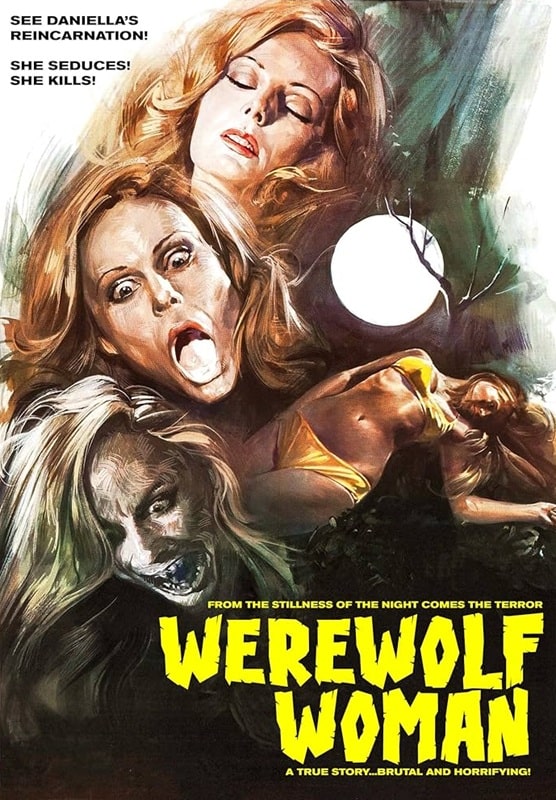
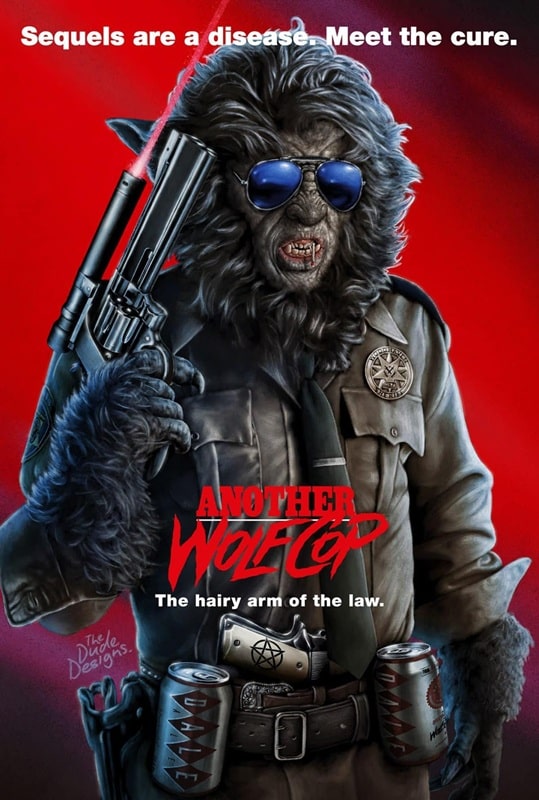
Werewolf Woman (Agorà, March 18, 1976) and Another Wolfcop (RLJE Films, July 29, 2017)
Man or beast? Naked, hairy, black-nosed lady.
Howling’ good time? Apparently, this is a favorite of Quentin Tarantino, but I swear half of his favorites are just obscure titles that he had access to while working in a dodgy video store that he could use as bragging rights. It has elements of revenge flicks that he would use in his own films, but the rest is a messy potpourri of sex, violence, and sexual violence. This being the 70s and Italian, the main feature is hair, whether it is covering the voluptuous frame of the titular lady, the upper lips of the men, or more nether-regions than a topiary enthusiast could ever dream of.
It’s a sordidly strange tale of a woman who is horrifically raped and her lover murdered, who exacts revenge in the guise of a werewolf without any transformation due to recurring dreams that she is the descendant of a werewolf. Confused? You will be. Weird, uncomfortable, badly dubbed.
Can’t say I loved it – but it had a couple of decent moments and some good old-fashioned Italian exploitation gore.
6/10
Another Wolfcop (2017) PrimeMan or beast? Great, practical, wolf. Cop.
Howling’ good time? A proudly Canadian production, this sequel takes the original concept (cop Lou Garou is bitten by a werewolf and brings his new persona to the job) and ramps up the insanity. Reptilian mutants, moustachioed parasitic stomach worms, extremely hairy sex, extremely gory deaths, Gowan on repeat and Kevin Smith yelling ‘slam a cold cock!’ at any given moment. It’s stupid as all hell and I loved it.
Bonus points for enormous werewang.
8/10
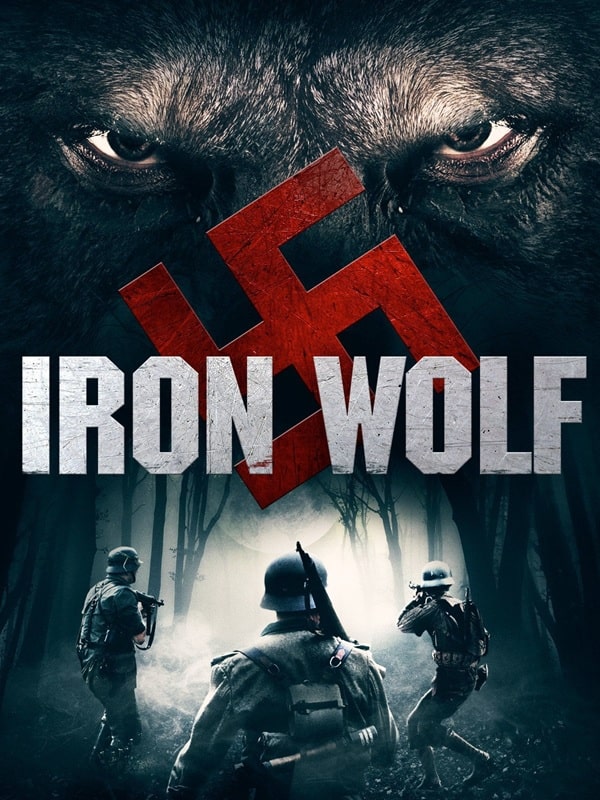
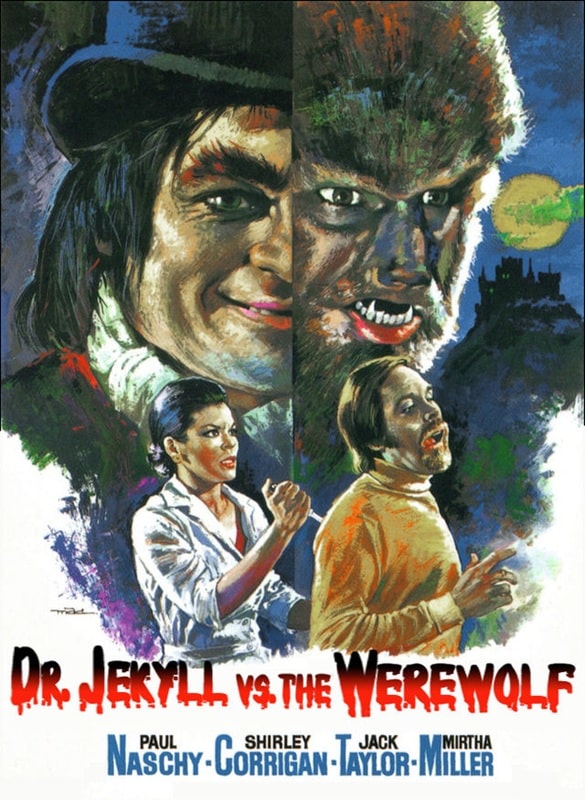
Iron Wolf (RJ Nier Films, September 13, 2013) and Dr. Jekyll vs. the Werewolf (Filmaco, 1972)
Man or beast? Ruby’s bottom of the line costume.
Howling’ good time? Don’t be fooled by the poster (or any poster for that matter), this is not a jolly werewolf romp set in WW2. The film begins that way, with some mis-matched Nazis working in a secret lab (industrial site) and showing off their werewolf that they have trained to only attack non-Nazis.
It’s cheap and cheerful, and somewhat passable, but then is brutally cut short and jumps forward in time to some extremely dull modern, German teenagers. They are hanging around the semi-ruined labs for some B.S. reason, the wolf creature gets out, and it becomes a ‘desperate fight for survival’. The direction is pretty limp, and the acting isn’t great – I really wish the German cast had been allowed to speak German and for the film to be subtitled. It makes no sense to flatly deliver the lines – lines that are flat to begin with.
As usual, the only saving grace could have been the werewolf, but this big doofus is just a dude in a Halloween wolf costume (and not the deluxe version) stuffed into a Nazi uniform. Laughably bad.
4/10
Dr. Jekyll vs. the Werewolf (1972) TubiMan or beast? Hairy-faced fella.
Howlin’ good time? I’m no stranger to Paul Naschy werewolf flicks, but this is one of the dozen movies he made that I missed. As with the other Spanish-produced films in this series, Naschy plays the wolfman, searching for a cure, and the whole shebang has that lovely dark gothic feel of the other films.
However, this one has a personality split as broad as the titular characters. The first hour is tedious, lots of sitting around talking, but then, once Dr. Jekyll’s grandson starts shooting up the wolfman, it goes batshit crazy. Cue Hyde going on a sadistic rampage, whipping every bosom he lays eyes on, go-go dancing, drunk tipping and other nefarious tomfoolery. It’s not enough to save the movie, but it is daft enough to warrant an extra mark.
5/10
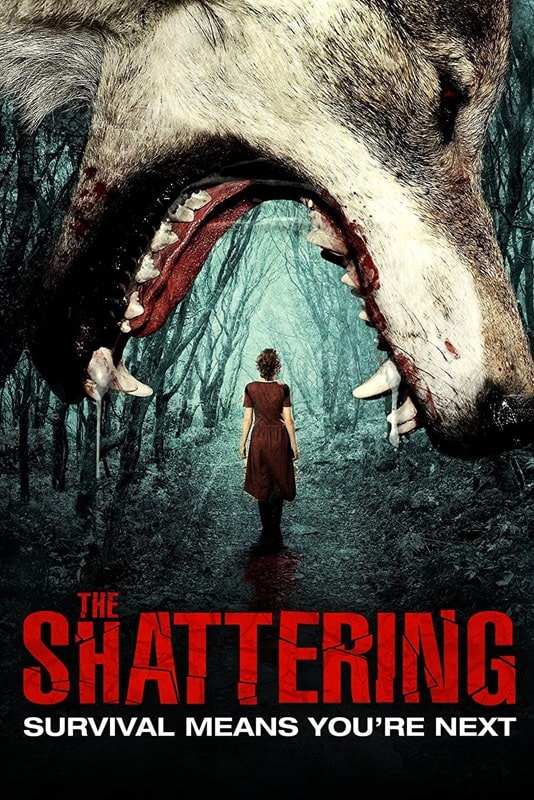
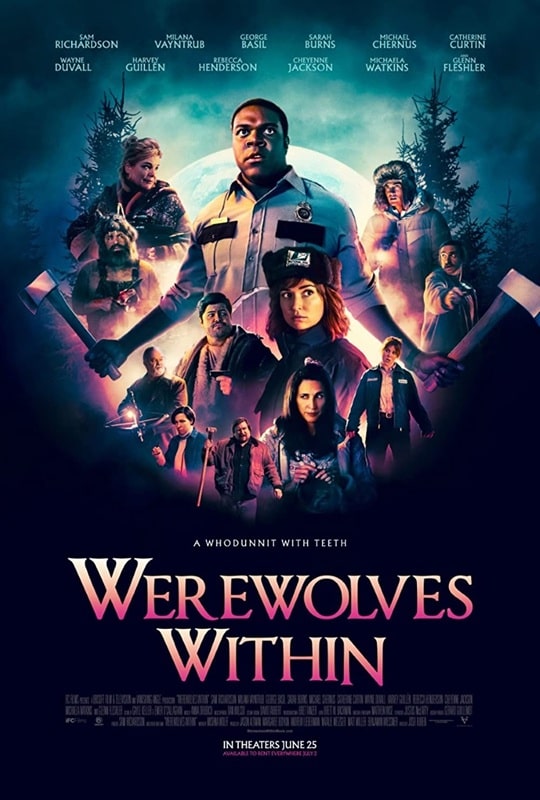
The Shattering (Film Cartel Entertainment, March 24, 2015) and Werewolves Within (IFC Films, June 25, 2021)
Man or beast? Unseen thingy.
Howlin’ good time? Let’s get this one out of the way. A group of randos are stuck in a cabin due to a bullshit plot line involving a healer. Some hunters are stuck in the woods due to some bullshit plot line about collecting wolf spit. A POV camera eats most of them. A very bold decision to not show a single werewolf in this badly shot, badly acted, werewolf flick. The only shattering that went on was in my pants when I realized I had to sit through this tedious dirge.
3/10
Werewolves Within (2021) NetflixMan or beast? Nice, practical werewolf.
Howlin’ good time? I really should have saved this until last, but I needed a little pick-me-up, and this sure hit the spot. Based on the videogame Werewolf, this film is a joy from start to finish. It’s a horror comedy in the same vein as Shaun of the Dead, even going so far as to include some Edgar Wright-type editing, and for the most part, the comedy sticks the landing.
It helps that the two leads are so likeable and awkward; Sam Richardson is perfect as a spineless park ranger, and Milana Vayntrub is adorable (and renews my pining for the aborted Squirrel Girl series). The setting is a hokey town in Vermont, full of troubled characters that put me in mind of Northern Exposure, or even Twin Peaks, and the plot weaves in a bit of social commentary about pipelines, gentrification, and acceptance.
For a further comparison, I had as much fun with this as I did with The Beast Must Die, and I even guessed correctly! Highly recommended.
9/10
Previous Murkey Movie surveys from Neil Baker include:
What a Croc
Prehistrionics
Jumping the Shark
Alien Overlords
Biggus Footus
I Like Big Bugs and I Cannot Lie
The Weird, Weird West
Warrior Women Watch-a-thon
Neil Baker’s last article for us was What a Croc, Part III. Neil spends his days watching dodgy movies, most of them terrible, in the hope that you might be inspired to watch them too. He is often asked why he doesn’t watch ‘proper’ films, and he honestly doesn’t have a good answer. He is an author, illustrator, outdoor educator and owner of April Moon Books (AprilMoonBooks.com).
Comment on Worldbuilding Articles: 2025 Reader Poll Results by Cindy Houghton
I had hoped the ‘Sigl Fashion’ option would have scored higher… I figured with the nobility and ultra wealthy type of folks, sigl jewelry would almost reach a ‘crown jewels’ sort of function. You become head of house, or the heir apparent, you get something like a signet ring, like the official ducal seal worked into the ring Paul inherits from his father as Duke Atreides in Dune. Or the signet ring Hadrian wears in the Sun Eater series, as a sign of his status and rank as a Palatine. The King still wears the three feather signet ring of Wales, like he did as Prince of Wales. The new heir or head of house would get the ring, just getting a new sigl created and mounted in the antique setting.
Also, I figured with the younger crowd and the fact some sigls need to be worn close to the skin, that sigl jewelry piercings would be more widespread than they apparently are in the series so far.
DOGE- Supernatural Division (episode 4)
It’s Hughday Again! Chapter 3
Thank you for kind comments and support this week. Usually we post scene by scene, but today we will do the whole chapter.
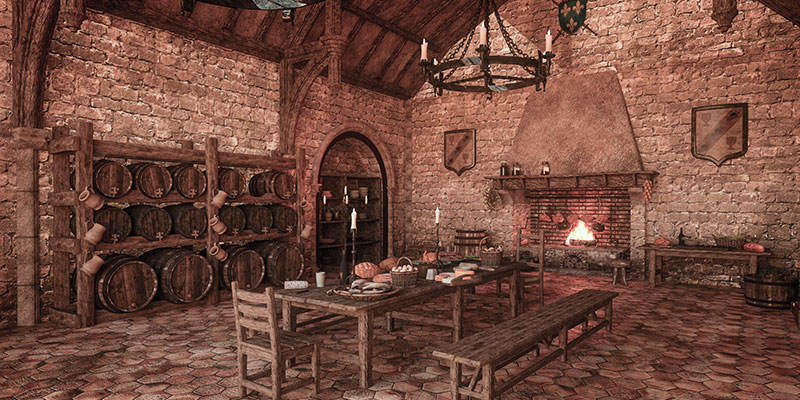
Hugh stepped out of the woods and started up the road to Baile. The old castle rose atop the low hill like some ancient fort built by a Norman knight intent on keeping all he surveyed clenched in his iron gauntlet. It had been born in England, then transported stone by stone to Kentucky and reassembled on a whim of a man with too much money. The Shift had restored its original purpose. It was both a fortified base and a symbol of power.
He once told Elara that the point of the castle wasn’t to hide within the walls but to be worthy of it. The man who controlled the castle controlled the lands around it.
He needed to be that man. Not because he wanted the headache but because maintaining control of their immediate surroundings was the only path to safety. They were too far from any regional authorities, and in the great scheme of things, his fighting force was laughably small. By the latest count he had 348 Iron Dogs. During his time as Roland’s warlord, he commanded 2,400 trained soldiers. Almost seven times what he had now.
The familiar rage shivered deep inside him, hot and angry. He had built the most elite force on the continent and Roland had dismantled it out of cowardice.
Hugh pushed it aside. He needed a cool head for what waited ahead.
Aberdine presented a problem. The small town controlled the only leyline point within twenty five miles. The magic current was the fastest and safest way to reach Lexington or any of the other cities, and Baile depended on trade. Herbs, cosmetics, medicine, all of that flowed out through the leyline and returned as cash and supplies. In the past, Aberdine proved less than cooperative, despite relying on Baile’s medical supplies and booze.
Given a choice, he would have done whatever he could to take charge of Aberdine. In the old days, when Roland’s magic seared all doubt, guilt, and compassion from his mind, he would’ve set the town on fire, built a fort on the ashes, and put a detachment of Iron Dogs into it.
Those days were behind him now. He was a different man, less powerful, without immortality or backing of Roland’s magic, but he had his freedom. It was hard won. He could still feel the void, swirling on the edge of his consciousness, ready to sink its teeth into him if he faltered.
He was also married and charged with defending about 5,000 civilians who depended on his protection and ability to negotiate. The fact that Aberdine sent someone over and asked to see him meant both would be required.
His lovely wife was waiting for him by the castle gates. She wore a light lilac dress today, and her white hair, gathered into a plait, wrapped around her head like a crown.
He’d half expected her to have been deep in negotiations with whoever Aberdine sent. For some reason, he was happy that she waited for him.
Hugh walked through the gates. She gave him a weary look.
“I heard we have guests,” he said.
“Nick Bishop and two others,” she said.
She looked like something had been eating at her. It bothered Hugh.
“Where are they?” he asked.
“Waiting inside.”
They started toward the keep, walking side by side. The bailey was crowded with people hurrying back and forth. A team of villagers hung fall garlands on the walls. Another trio had brought a cart filled with bright orange pumpkins and were now arguing over the most picturesque location to position it while an old pinto horse patiently waited for them to make up their minds. A gaggle of tweens carried baskets of chestnuts. The castle was getting ready for Harvest Day.
“What do you think they want?” Hugh asked.
“I don’t know, but Bishop’s arm is in a sling and the other two have bruises on their faces. Whatever it is, it can’t be good.”
Nick Bishop was Aberdine’s chief of police, National Guard Sergeant, and Wildlife Response Officer, all of which put him in charge of the same six people. He’d met Bishop during the battle of Aberdine. The man kept a cool head and was capable.
If Bishop had showed up, Aberdine had a problem. One that required an Iron Dog kind of solution. This wasn’t about herbs or beer. This was about violence.
Ah. “So it’s that kind of visit, then.”
Elara didn’t respond. She was walking fast, her gaze dark, her lips a thin firm line.
“The herbs?” he guessed.
“That too, but mostly it’s Aberdine.”
They entered the main keep and Elara turned left, down the hallway leading to the visitor room. He remembered it well. When he first came to Baile a few months ago, half-starved and only barely sane with the void gnawing on his soul, she’d put them in that room. And then she made them sit in there, smelling delicious bread baking in the kitchen for half an hour before she came to negotiate.
“What about Aberdine?”
“They sent their Chief of Police. They’re going to ask you for help. They’re going to expect you to take the Iron Dogs, leave the castle, go source alone knows where, and fight.”
“That’s what people usually want from me.”
She stopped and turned to him. “I don’t want you to go.”
Interesting. “I seem to remember a certain woman who demanded that I drop everything and take our troops to defend Aberdine not that long ago. And when I argued against it, she tried to shame me by pointing out that Aberdine was full of babies.”
She raised her head. “That was then and this is now.”
“I’m going to need a little more than that.”
Elara sighed. “Then Aberdine was about to be wiped off the face of the planet. You saved them because it was the right thing to do. But now, since Aberdine survived, they should have the decency to handle their own problems.”
“That depend on the type of problem. There will be times when Aberdine’s issues could become ours.”
“And that’s exactly what I don’t want. I don’t want you getting hurt, I don’t want any of our people getting hurt, and I don’t want to take in anymore of their people. I just want to celebrate Harvest Day in peace. I’ve had enough of blood and gore.”
Ah. He got it now. For him, blood and gore were business as usual. The battle with Nez, terrible as it had been, was just another fight. He had personal stakes in that one, and he’d almost died, but at the core he was a soldier. An enemy attacked, they fought, they won. Next.
Elara didn’t fight those kind of battles. She avoided them unless she was backed into a corner, which was why she and her people migrated from place to place until they found Baile. Any time they came in conflict with the locals, they picked up and moved on. She married him to break that cycle.
His prickly wife, as tough as she pretended to be, was scared.
“They’re here,” he said. “Let’s hear them out and then we can decide, together, if we’re going to do anything about it.”
She gave him a suspicious look.
“I promise you that if you really don’t want me to go, I won’t.”
She took a step forward, closing the distance between them, and put her hand on his forehead. Her fingers were cool and dry, and he had the absurd urge to take her hand and kiss it.
The swirling, writhing chaos spreading, engulfing him…
Nope.
“I don’t have a fever.”
She stepped back. “I’m not going to tell you what to do.”
“Noted.”
They looked at each other.
He raised his eyebrows at her. “Wait, are we acting like a married couple?”
“Oh, shut up.”
She turned and stomped down the hallway. He followed her.
The scent of freshly baked bread floated on the draft. He could practically taste the crispy crust.
“Loving couple in three, two….” He murmured.
“One,” she finished.
The doors of the visitor room stood wide open. He let her enter first and stepped inside behind her. The long rectangular room held an oversized table built with old wood. The Aberdine delegates, Bishop and the two other men, sat at the table, helping themselves to a platter of fresh bread, cheese, sausage, and fruit.
There was a subtle psychology at play here. She brought them in, she made them wait, she fed them. It wasn’t just hospitality. Elara was positioning Baile as the benefactor of Aberdine. There was something almost feudal about it. The lord and lady of the castle receiving vassals in need of assistance. If they chose to grant their ask, the relationship between Baile and Aberdine would be cemented. Not neighbors. Not equals. Protector and protected.
Hugh hid a smile. That’s my girl.
He couldn’t let all of that effort go to waste.
#
Hugh raised his large arms and gave Bishop a big toothy grin. “Bishop! It’s been too long!”
Elara almost winced. She should have been used to him by now, but his instant transformations still took her by surprise. A moment ago, in the hallway, he was quiet and serious, and he sounded sincere. And now he’d turned into a loud, affable, slightly oblivious bro host with the emotional depth of a wooden spoon.
Hugh squinted at the table. “Love, couldn’t we get the guys some beer?”
“Of course, honey.” She nodded at Natasha waiting in the other doorway.
Hugh landed in a chair and spread out. She stood next to him. The nervous energy inside her roiled. Sitting down wasn’t in her right that second. She could barely keep from pacing.
Hugh grabbed a bread roll, tore it in half, stuffed some cheese into it, and took a bite. “So, what are you guys doing here?”
Bishop gathered himself, as if preparing to jump over a pit studded with spikes. His left arm was in a sling and his face was bruised, his dark brown skin almost purple over his left cheek. The other two didn’t look much better.
The unease spun inside her like an animal with sharp claws. When Nez captured Hugh at the end of the battle, his vampires had dragged him to some old building in an abandoned town miles away. She had gone to get him, and when she tore into that building, she found him chained and bleeding. They had hung him by his arms, and his body looked battered beyond repair. They had beaten him to the very edge of death. When she wrapped her power around him, he was almost gone and she carried him, limp like a ragdoll, all the way back to Baile hoping against all odds that he would live. He was so strong, the strongest man she’d ever met, and she had felt his life slipping through her fingers. He could have been gone forever.
Never again.
Hugh frowned. “Wait a minute. Bishop, what happened to your arm? Have you guys been having fun without me?”
Fun? You ridiculous oaf. She almost clenched her fists and forced herself to smile instead. “Hugh, dear, maybe we should let them tell us why they’re here?”
“Oh, yes.” Hugh rearranged his face into a serious expression. “To what do we owe the pleasure?”
The two men with Bishop stopped eating. The Chief of Aberdine’s police cleared his throat.
“We’re being extorted.”
Her stomach dropped. She hated that, hated the anxiety and how it made her feel. It was so much simpler before, when Hugh was an irritating but necessary jackass she had to tolerate. Somehow he had become her jackass. And now they would try to drag him into their mess.
“Extorted by whom?” Hugh asked.
“The Drakes. Mercenaries from Indianapolis,” Bishop said.
“They came down from up north three weeks ago,” the man to Bishop’s left said. He was in his forties, broad and blond. “At first they asked if they could pitch their tents in the fallow field by the wall. Now they want us to put them up and feed them through the winter.”
“How many?” Hugh asked.
“Seventy to eighty people,” Bishop said. “They’re armed and trained. Apparently the other half of their outfit is on its way.”
Eighty people. Even if they minded themselves, Aberdine couldn’t support that. And they wouldn’t mind themselves. Aberdine didn’t have a police force strong enough to keep them in check. They would start to swagger. They would start to demand and take. There would be theft, there would be assaults and rape. Then there would be murder. Here, isolated in the Knobs, there line between mercenary and bandit was very faint.
“Have you petitioned Lexington?” Hugh asked.
Bishop nodded. “National Guard won’t come unless there is an incident. Right now, it’s just squatting. A civil matter. Non-violent.”
Elara knew exactly where Aberdine stood. She and her people had been in a standoff just like that more than once, when someone wanted them to leave. Somebody would have to die or be seriously injured before the authorities intervened, and it wasn’t worth it. Her people were precious. She had chosen again and again to just move on. But Aberdine didn’t have that option. Where would the whole town go with winter a month away?
They would have to rescue Aberdine. She saw it with crystal clarity, and she hated it. First, they couldn’t allow the Drakes to control the leyline. Second, they couldn’t permit Aberdine to turn into a mercenary town. Those places popped up from time to time, lawless settlements that drew every lowlife in the state until it became too much and either National Guard or DCI, Department of Criminal Investigations, busted them. If they let Aberdine devolve into that, sooner or later the mercenaries would start eyeing Baile. They would need space and a good defensible position, and the castle would prove too tempting.
All that aside, morally they couldn’t allow Aberdine’s people to be run off their own land. As Hugh pointed out, there were children in that town. Families. They didn’t deserve any of that.
A careful knock sounded through the room. Lamar paused in the doorway. Hugh waved him in without turning.
“Who is running the show?” Hugh asked.
“A man named Polansky,” Bishop answered.
“Calls himself the Falcon,” the dark-haired man to Bishop’s right said.
Lamar leaned to Hugh and murmured something in his ear. Hugh nodded.
“Ex-marine, big guy, always sunburned, looks like he bites bricks for a living?” Lamar asked.
“That’s the one.”
“I thought once you were a marine, you were always a marine?” Hugh said.
“They kicked him out,” Lamar said. “Conduct unbecoming.”
“Meaning?” Hugh asked.
“His definition of acceptable civilian casualties was too broad for the Corp.”
Hugh looked at the three men. All humor had disappeared from his face. His gaze was hard and heavy. “And what would you gentlemen like us to do about this unfortunate development?”
“We’ve been authorized by the town to pay you a substantial sum to help us resolve this crisis,” the blond man said.
A mistake, Elara thought. They should not have opened with that.
Bishop gave him a warning glance. The man clamped his mouth shut.
“We are not for hire,” Hugh said.
He spoke in an unhurried, almost lazy way, but the temperature in the room had dropped by about ten degrees.
The blond man paled.
“And if we were, you couldn’t afford us.”
Silence claimed the room, siting on the table between Hugh and the Aberdine men like a cement block.
Bishop cleared his throat again. “We know you’re not for hire. The money would be just to offset any costs.”
That was her cue. “We don’t need Aberdine’s help with that.”
Hugh reached for her hand, took it, and brushed his lips on her fingers.
Ridiculous. She’d make him pay later.
He was still holding her hand and showed no signs of letting go. “My wife is quite right, gentlemen. We are not destitute. We can cover our own costs.”
“We would be happy come to an agreement regarding our western woods,” the dark-haired man said.
She knew exactly what they were talking about. The land between Baile and Aberdine was almost all dense forest, but there was a stretch of meadows right near the property border, on Aberdine’s side. The meadows produced particularly good blueflower.
It was one of those plants that popped up after the Shift, nourished by magic. Blueflower provided relief from arthritis. They had tried to cultivate it before and failed. It could only be gathered in the wild and no matter how long they searched, they never found another spot on their own land. She had tried to license foraging rights, and Aberdine had turned her down cold. They hadn’t been pleasant about it, either.
It would be nice to have that plot. But there were bigger things in play. Aberdine always viewed them as unclean and lesser. There was a reason why they opened with the money. If they agreed to be hired, it would put Aberdine and Baile in employer and employee positions, with employer holding power. Now that that attempt failed, they were trying to bargain as equals.
No, this could not be a transaction. It had to be a favor. Aberdine had to owe them. That was the only way they would be secure.
High squeezed her hand gently. She looked at him and saw a silent question in his blue eyes. It almost killed her, but she gave him a tiny nod.
A hint of a smile tugged on the corner of his mouth.
“Do we need any more woods, love?” he asked.
“Not particularly.”
“You’ve tried to get foraging rights before,” the blond man said. He had to be their comptroller or something.
“I did. As I recall, Aberdine doesn’t want dirty, pagan witches in its woods. Isn’t that right?”
The delegation winced in unison.
“That was the old mayor,” the dark-haired man said. “He has left town. Aberdine doesn’t not condone that sort of small-minded prejudice.”
Since when?
“As I recall, we tried to help you before. We sent people to reinforce your magic wards, and you blocked their way and threw rocks at them,” she said mildly.
The delegation stared at her. At least they had the decency to look uncomfortable.
“We apologize,” the dark-haired man said.
“That’s very nice of you,” she told him. “I will let Will know. He has a scar from the rock on his forehead. Your apology will be a great comfort.”
More silence.
“That was then, this is now,” Bishop said.
Hugh looked at her.
Don’t even think of saying anything.
“Look, I’ll level with you,” Bishop said. “We can’t get them out ourselves. We’ve tried.”
He pointed to his arm.
“They’ve stopped pretending to be polite. They’re going to start looting and pillaging next, and there’s not a damn thing we can do to stop them. Will you please help us?”
Silence stretched for a long moment.
Hugh grinned. “All you had to do was ask. Of course we’ll help you. After all, we’re neighbors, aren’t we, honey?”
“We are,” she said.
“There you have it. My wife is a very forgiving woman.”
He would leave right away. She could feel it. “Will you be back in time for dinner?” Go there, do your Hugh thing, and come right back.
He kissed her fingers again and gazed at her, his face a picture of adoring devotion. “Will you make me something delicious to eat, love?”
“Of course.” She had plenty of poisonous herbs left over…
Hugh rose to his full height. “Let’s go see about these mercenaries of yours.”
The post It’s Hughday Again! Chapter 3 first appeared on ILONA ANDREWS.
The Unseelie King - Book Review by Voodoo Bride
 The Unseelie King (Maze of Shadows #4)by Kathryn Ann Kingsley
The Unseelie King (Maze of Shadows #4)by Kathryn Ann KingsleyWhat is it about:One king is dead, and the other is in chains.
Tir n’Aill perches on the edge of a knife in the wake of a series of betrayals that has shaken the fae to the core.
Abigail finds herself questioning who is friend and who is foe. When she is forced to make her decision between mercy and love, she finds her choice is one that might tear the very world apart.
Forces gather to wage war and decide the fate of Tir n’Aill. And in the center of it all, Abigail is nearly torn in two, caught between her desire to protect her new people and her love for Valroy.
For he is now the Unseelie King. The world is his to burn.
And only she can stop him.
What did Voodoo Bride think of it:*more spoilers ahead*So I gave this book a 5 star rating on Goodreads, and I stand by it, but this book destroyed me.
I know I talked mainly about Abigail and Valroy in my other reviews, but there were other really cool characters as well. Especially Anfar, the best (and probably only) friend of Valroy.
In this book things get dark, gruesome, but it seemed there could be a solution that would lead to a satisfying ending. And to be fair: there is a kind of bittersweet Happily Ever After if you don't overthink it. But the costs to Valroy and Anfar: too high in my opinion. I cried so hard over the ending. That'll teach me to fall in love with a dark creature from the Unseelie Court and his 'creature from the depth of the ocean' best friend.
All in all this is a great series, but I might be too soft for it, and too invested in friendship over the main romance.
Why should you read it:It's a really good if you can handle the dark stuff in it.
Comment on Worldbuilding Articles: 2025 Reader Poll Results by Kevin
In our defense I thought Byron implied that knowledge about the Winged was known in the Drucraft world, I believe he mentioned the Mountains and the Cathedrals to Lucella and there seems to be mythological figures mentioned like Ogun and Perun that seem to be gangs/criminals/pseudo Cults. So just general information that isn’t too spoilery since they are so powerful and influential some information must be known to the average drucrater without going to overboard, kinda of how the average person knows Special Forces exists but not know how and where they function.
But aside from that looking forward to learning about the Corporations Essentia capacity Branch affinities and the rest!
(I will miss learning about the Drucraft branch affinities with their cultural associations plus what planets the rest are associated with, I want to know how far out we get possibly to Uranus or Neptune or if the Moon and Earth count for ones.)
The Fiction of Edgar Rice Burroughs, Part IV: The Hollow Earth and Pellucidar
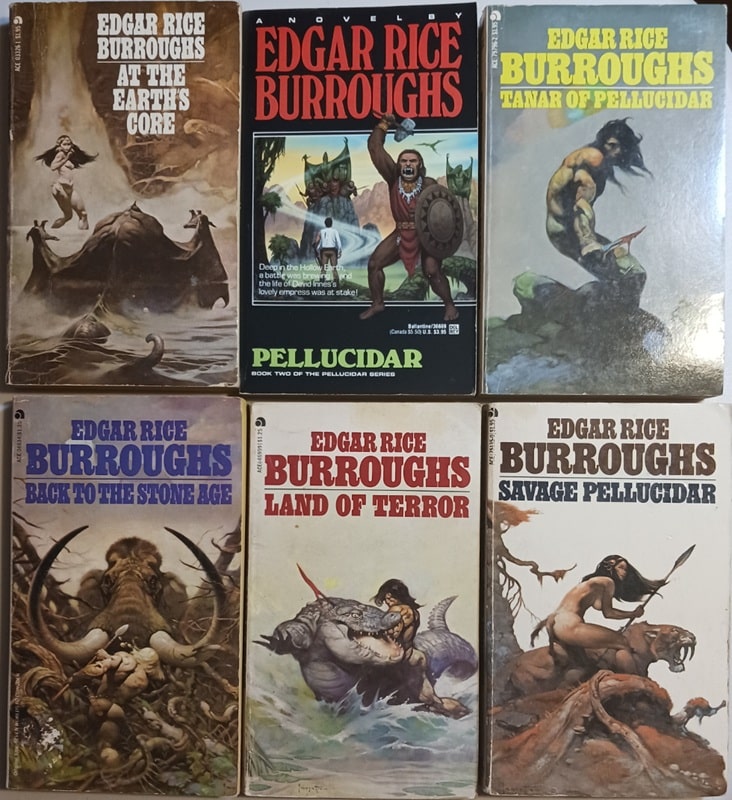 The Hollow Earth novels of Edgar Rice Burroughs: At the Earth’s Core (Ace Books, August 1978), Pellucidar (Del Rey, May 1990), Tanar of Pellucidar, Back to the Stone Age, Land of Terror, and Savage Pellucidar (Ace Books, January 1973). Covers by Frank Frazetta and David Mattingly (Pellucidar)
The Hollow Earth novels of Edgar Rice Burroughs: At the Earth’s Core (Ace Books, August 1978), Pellucidar (Del Rey, May 1990), Tanar of Pellucidar, Back to the Stone Age, Land of Terror, and Savage Pellucidar (Ace Books, January 1973). Covers by Frank Frazetta and David Mattingly (Pellucidar)
Above are my Edgar Rice Burroughs Pellucidar books. Tarzan at the Earth’s Core goes with this series as well, although I included it in Part II of this series, with my Tarzan collection. In these stories, Pellucidar is a hollow area at the center of the Earth. There are openings into it at the North and South poles, but in the initial book, At the Earth’s Core, an American named David Innes reaches the interior by riding inside a giant drill. This is kind of a reverse of the Sword & Planet plot in which the Earthman is taken outward to another world.
Pellucidar is an interesting construction and ERB clearly gave it some thought. There’s a miniature sun at the center that leads to perpetual day, and the only shadowy area on the surface of Pellucidar is an area of constant twilight beneath the bulk of the unmoving moon. The interior has no horizon because everything curves up and away from the viewer, and the land and water masses are the reverse of the surface, leaving a lot of land. The world is populated by all kinds of extinct outer lifeforms that wandered in through the polar entrances, including some dinosaurs and the remnants of the mammal megafauna.
It also contains humans, and some weird races that never existed on the surface, including the Mahars, who are winged reptilian-like beings possibly evolved from Pterodactyl-like ancestors. The Mahars rule the interior world and David Innes leads a revolt against them that is fought out during the first few books. In Tarzan at the Earth’s Core, Tarzan takes an airship into the interior world and gets involved in the war. Some of the later books are made up of stories that were originally published separately.
There are 7 Pellucidar books, listed below with first publication dates. My copies are all later releases, of course, and all from Ace Books, except for Book 2, From Del Rey. I’ve also listed the publication dates and cover artists here for my copies.
At the Earth’s Core, 1914: 1978, Frazetta
Pellucidar, 1915: 1990, David B. Mattingly
Tanar of Pellucidar, 1929: 1978, Frazetta
Tarzan at the Earth’s Core, 1929-1930 (not shown above)
Back to the Stone Age, 1936-1937: Frazetta cover (My Favorite)
Land of Terror, 1944: 1973, Frazetta
Savage Pellucidar, 1963: 1978, Frazetta
I like the Pellucidar series a lot, and it was the single biggest influence on Lin Carter’s Zanthadon, which I wrote about in a Facebook post quite a while back.
 Lin Carter’s Zanthodon novels: Journey to the Underground World, Eric of Zanthodon, Hurok of the Stone Age, Darya of the Bronze Age, and Zanthodon (DAW Books, November 1979, May 1982, February 1981, September 1981, and June 1980). Covers by Josh Kirby and Thomas Kidd (Zanthodon)
Lin Carter’s Zanthodon novels: Journey to the Underground World, Eric of Zanthodon, Hurok of the Stone Age, Darya of the Bronze Age, and Zanthodon (DAW Books, November 1979, May 1982, February 1981, September 1981, and June 1980). Covers by Josh Kirby and Thomas Kidd (Zanthodon)
The idea of a Hollow Earth that Burroughs used in his Pellucidar books, or at least of great caverns beneath the earth, is very old. Quite a few Native American tribes have origin stories that include them coming from out of hollows in the earth. Edmond Halley proposed it as a serious theory in 1692, and, of course, there’s Jules Verne’s Journey to the Center of the Earth, published in 1864.
A couple of years ago, my wife and I visited Mammoth Cave in Kentucky and saw evidence of Native Americans having visited and perhaps lived there. I also found out about a book with the lengthy title Wonderful Discovery: Being an account of a recent exploration of the celebrated Mammoth Cave, in Edmonson County, Kentucky, by Dr. Rowan, Professor Simmons and others, of Louisville, to its termination in an inhabited region, in the interior of the Earth.” I managed to find a copy online.
 Wonderful Discovery by Montgomery E. Letcher (Forgotten Books, August 24, 2018)
Wonderful Discovery by Montgomery E. Letcher (Forgotten Books, August 24, 2018)
Written in 1839, this story purports to be a journey into the Hollow Earth through the Mammoth Cave system. It’s only a long opening chapter, and supposedly there were to be further installments. This is the only one I’m aware of. This piece has the intrepid explorers getting through the cave system into the inner world where they meet a peaceful group of humans. There’s not much excitement; no “narrative drive,” like you get from ERB.
I was unable to find anything on the author Montgomery E. Letcher. My search suggests this is the only work he ever did. The writing is, naturally, very old fashioned, and the concept was apparently derived from Halley’s suggestion of the Hollow Earth. The story precedes Jules Verne’s Journey to the Center of the Earth by decades, since that book was published in 1864. It seems likely to me, however, that Verne arrived at the idea directly from Halley’s writings rather than from having read this work. And I doubt Burroughs knew about it either.
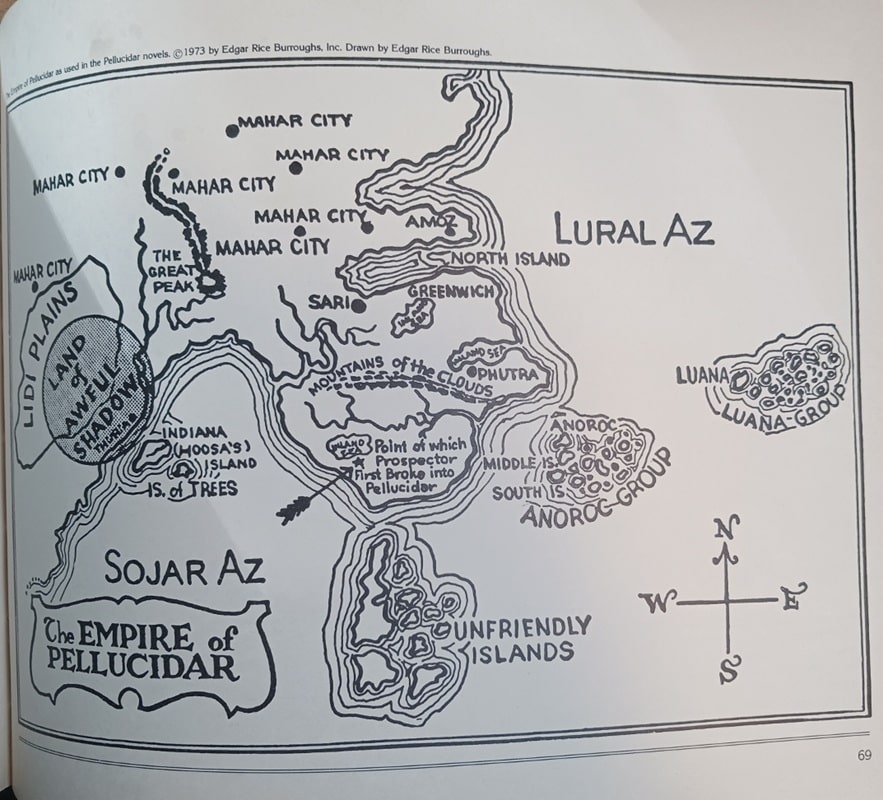 Map of Pellucidar from An Atlas of Fantasy by Jeremiah Benjamin Post (Ballantine Books, January 1, 1979)
Map of Pellucidar from An Atlas of Fantasy by Jeremiah Benjamin Post (Ballantine Books, January 1, 1979)
Above is a map of Pellucidar, from An Atlas of Fantasy. The same basic map is featured in some of the books as well. ERB drew it himself.
ERB and Some PastichesGetting back to ERB’s Pellucidar, there’s also a sequel to the series written by John Eric Holmes (1930 – 2010) called Mahars of Pellucidar. It follows the events of Savage Pellucidar. My copy appears to be from the first printing, from ACE, 1976, with a great cover by Boris. I actually enjoyed this tale quite a bit. It was authorized by ERB’s heirs, although they originally nixed a sequel Holmes wrote called Red Axe of Pellucidar. This was eventually published, with the consent of ERB, Inc, although I don’t have it and haven’t read it.
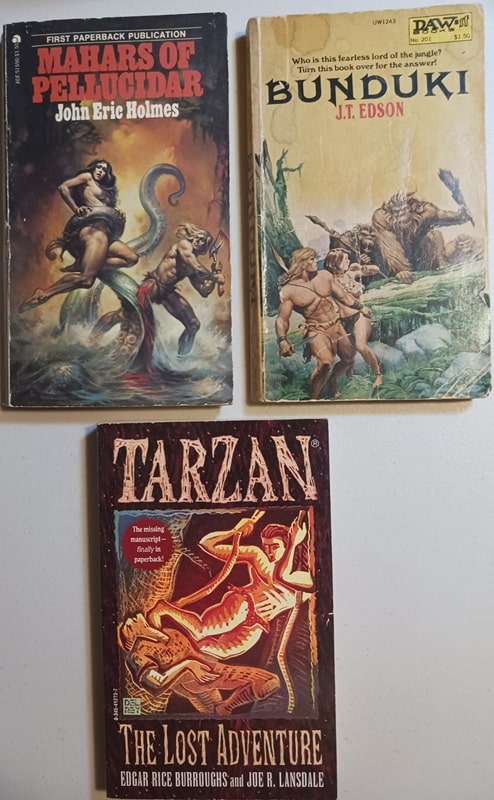 Mahars of Pellucidar by John Eric Holmes (Ace, 1976), Bunduki by J.T. Edson (DAW, April 1975), and Tarzan: The Lost Adventure, by Edgar Rice Burroughs and Joe R. Lansdale (Del Rey, June 1997). Covers by Boris Vallejo, Michael Whelan, and Raymond Verdaguer
Mahars of Pellucidar by John Eric Holmes (Ace, 1976), Bunduki by J.T. Edson (DAW, April 1975), and Tarzan: The Lost Adventure, by Edgar Rice Burroughs and Joe R. Lansdale (Del Rey, June 1997). Covers by Boris Vallejo, Michael Whelan, and Raymond Verdaguer
The other books I have shown above with Mahars is Joe Lansdale’s (1951-) fleshed out Tarzan novel Tarzan: The Lost Adventure, which he wrote from a long outline found in ERB’s effects after his death. It’s not quite a pastiche. Nor is it my favorite book from Lansdale, who has written many truly wonderful works. This is from Del Rey, first published in 1995. The cover is by Raymond Verdaguer. I’m sure this is perfectly competent work of art but it didn’t do much for me, and I don’t understand why they didn’t use one of the artists who did the great interior sketches, such as Gary Gianni or Michael Kaluta.
The last pastiche shown here is Bunduki, by J. T. Edson (1928 – 2014), cover by Michael Whelan. It features Tarzan’s adopted son and adopted granddaughter (Bunduki and Dawn). It throws us right into a mystery. Bunduki wakes up in a tree in a tropical jungle, but it isn’t Africa. He’s amazed since he was in a Land Rover that ran over a cliff and should have been dead. Dawn was with him but is missing. It turns out that the two have been mysteriously transported to another world, which turns out to be a counter-earth (opposite our Earth) called Zillikian. This makes it essentially a Sword & Planet novel, although pretty light on the sword part.
Edson wrote three approved novels of Bunduki and a fourth one and some short stories that were not approved by the ERB heirs. I’ve only read the first one but the complete series is:
1. Bunduki, 1975
2. Bunduki and Dawn, 1976
3. Sacrifice for the Quagga God, 1976
4. Fearless Master of the Jungle, 1980
Edson had written a partial fifth novel called Amazons of Zillikian, which was published in 2023. I’ve never seen it. Edson, a British author, was best known for his westerns, particularly a very long series about the Floating Outfit, which ran to 66 books. I’ve read one of those, which was rather intriguing since it involved Cowboys and Aliens.
I might have picked up the other Bunduki books but they are exceedingly expensive in paperback. They are cheap for the Kindle but I’ve got way too many books on Kindle already.
Previous installments in this series include:
The Fiction of Edgar Rice Burroughs, Part I: Sword and Planet
The Fiction of Edgar Rice Burroughs, Part II: Tarzan and The Land That Time Forgot
The Fiction of Edgar Rice Burroughs, Part III: The Westerns and The Mucker
Charles Gramlich administers The Swords & Planet League group on Facebook, where this post first appeared. His last article for Black Gate was The Fiction of Edgar Rice Burroughs, Part III: The Westerns and The Mucker.
Book Review: Greenteeth by Molly O’Neill
I received a review copy from the publisher. This does not affect the contents of my review and all opinions are my own.
Mogsy’s Rating: 4 of 5 stars
Genre: Fantasy
Series: Stand Alone
Publisher: Orbit (February 25, 2025)
Length: 320 pages
Author Information: Website
Here I go again, writing a review for another historical fantasy novel inspired by fairy tales and folklore. That said, every so often, a book will emerge that puts a fresh spin on an old story or bases its premise on lesser-known mythological creatures. I, for one, had never heard of Jenny Greenteeth, or Wicked Jenny, before picking up Greenteeth by Molly O’Neill. A kind of bogeyman-type water monster from English folklore, her name was used to warn careless children away from the treacherous shores of lakes and rivers, lest Jenny pulls them in and drowns them. Huh. It’s always great to learn something new.
Obviously, the novel Greenteeth centers on this terrifying figure, who is typically depicted as an evil hag ready to snatch her unsuspecting young victims and drag them into the murky depths. O’Neill, however, prompts readers to look at Jenny in a whole new light. She’s a monster, all right. But monsters can have feelings too, and they can sometimes be the hero instead of the villain. Living in her secluded lake, Jenny can get lonely. And whenever a human wanders close to her abode, she just can’t help her curiosity.
One day, her inquisitive nature leads to a decision that changes everything. Accused of witchcraft, a woman named Temperance from a nearby village is thrown into the lake by an angry mob led by their fanatical new preacher. Against her better judgment, Jenny chooses to save her, sheltering Temperance and letting her recover in her lair. Soon, the two of them find themselves in an alliance against an emerging foe that threatens both Jenny’s lake and Temperance’s family. Bound by magic, the two of them seek help from Brackus, a traveling goblin trader who deals in magical reagents and information. The trio next sets out on a quest to save their home, a journey that takes them across the lush British landscape and even to the very heart of the faerie realm.
There’s a lot to love about Greenteeth. The world-building is particularly robust, immersing readers in its rich atmosphere as well as the myths that inspired the characters and setting. The author doesn’t skimp on the details; you’ll notice how elements from all kinds of sources make their way into the novel, including Arthurian legends, Old English literature, Celtic mythology, and real history. Her prose is also very well suited to the vibes she wants to convey—a world that feels both grounded and magical, neither fantasy nor reality but straddling that in-between space, giving it all a dream-like quality.
And yet, this approach also has the downside of making the plot feel overly simplistic, almost like a children’s tale. This became especially true when Jenny, Temperance, and Brackus were tasked to do a bunch of what were essentially fetch quests, a narrative structure that’s both formulaic and predictable. At times, even the characters’ personalities felt underdeveloped, reduced to broad emotional strokes that, unfortunately, ended up defining them. One of the story’s most significant conflicts, for example, stemmed from little more than Jenny throwing a massive temper tantrum. While it’s an incredibly effective way to humanize our monstrous protagonist, I confess to being somewhat disappointed that, under all those sharp edges which made Jenny so mysterious and intriguing, all we got was a petulant child.
Still, for a debut novel, Greenteeth is an impressive achievement and an excellent entry into its genre category. Molly O’Neill’s love of fantasy and folklore is clear from her descriptive prose, as is her affection for the legendary figure of Jenny Greenteeth, whom she writes about with care and compassion. Sure, there were a few things that could have used more polish, but despite these flaws, Greenteeth showcases a promising new voice in fantasy. While it might not be anything groundbreaking, I found it to be a very worthwhile and enjoyable read.
![]()
![]()
Goth Chick News: Getting Our Heavy Metal Back…
 Heavy Metal #319, the penultimate issue of the original run (November 2022). Cover by Pascal Blanche
Heavy Metal #319, the penultimate issue of the original run (November 2022). Cover by Pascal Blanche
Okay, strictly speaking, this topic doesn’t fall into a standard (notice I didn’t say “normal”) Goth Chick category. But bear with me for a short story.
A long time ago in a small midwestern town far, far away, I experienced my first hardcore crush. The subject in question was not only tantalizingly a few years older than me but he was decidedly gothy in a dark-warrior kind of way. Therefore, in my youthful opinion, he was perfection on two feet. That same year as I was sitting cross-legged on the floor of my local bookstore my eyes fell on an issue of Heavy Metal magazine where low and behold was my crush, or someone who looked darn close, personified in all his brooding magicalness, right there on the cover. That day my allowance went to my first issue of Heavy Metal and though I was a rabid fan for years afterward, I admittedly became hit and miss, buying only sporadic issues throughout the 2000’s.
Heavy Metal magazine, which had been in constant publication since 1977, printed its last issue in 2022 after a series of attempts to keep it viable, and an era came to an end.
Until now.
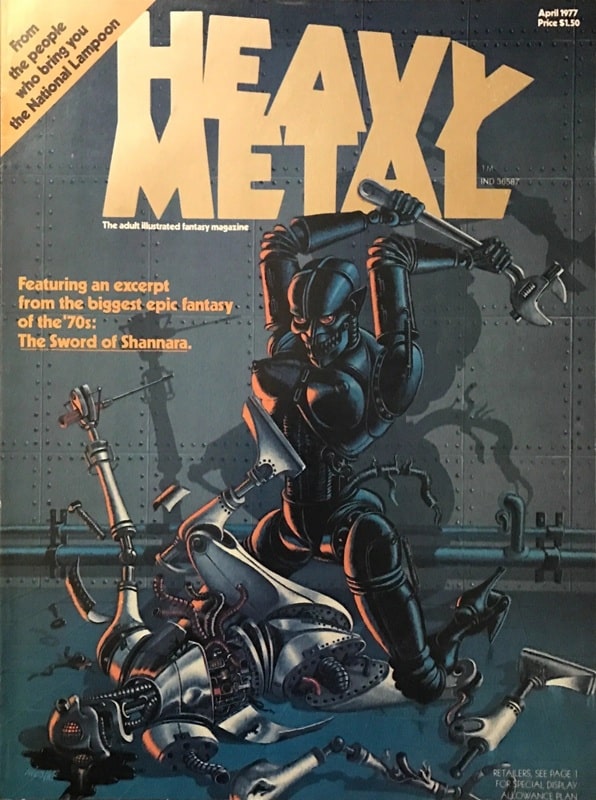 Heavy Metal issue #1, April 1977. Cover by Jean-Michel Nicollet
Heavy Metal issue #1, April 1977. Cover by Jean-Michel Nicollet
Before we get to that, let’s back up for some history.
Heavy Metal debuted in April 1977, bringing avant-garde European comic art and adult-oriented storytelling to American readers. Inspired by the French magazine Métal Hurlant (“Screaming Metal”), Heavy Metal was launched by Leonard Mogel, who licensed the rights to translate and publish content from its French counterpart. The magazine quickly distinguished itself with its blend of science fiction, fantasy, horror, and erotica, rendered in fantastic artwork and experimental narratives.
In its heyday, the contributors to Heavy Metal included legendary artists like Moebius, H.R. Giger, and Philippe Druillet, alongside American talents such as Richard Corben. Heavy Metal became the go-to publication for visionary creators, showcasing serialized stories, one-shot comics, and memorable (and boy were they memorable) covers that pushed boundaries all over the place.
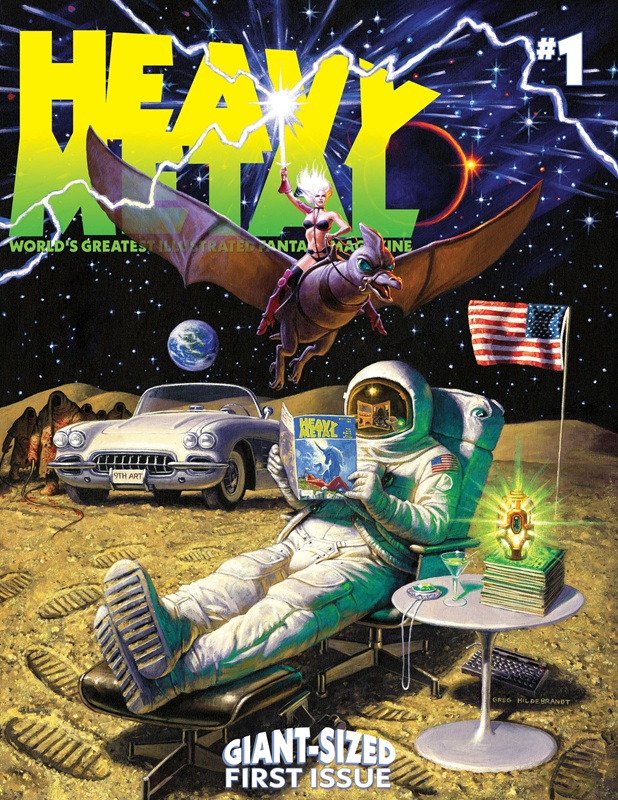 Heavy Metal #1 (April 30, 2025). Cover by Greg Hildebrandt
Heavy Metal #1 (April 30, 2025). Cover by Greg Hildebrandt
The magazine reached a broader audience with the release of the cult animated film Heavy Metal (1981), an anthology of shorts inspired by its comics and featuring a soundtrack of iconic rock and metal bands. This cemented its reputation as a cultural touchstone for fans of both countercultural comics and rock music.
Over the years, Heavy Metal evolved under various editors and owners, including Kevin Eastman, co-creator of Teenage Mutant Ninja Turtles. In January 2014, its ownership transitioned to digital and music veteran David Boxenbaum and film producer Jeff Krelitz. Eastman, though stepping back from majority control, remained as publisher until 2020 and retained a minority stake in the magazine under Heavy Metal Media, LLC.
In early 2020 CEO Matthew Medney and “Creative Overlord” David Erwin (formerly of DC Entertainment) took the helm. They launched new publishing initiatives, Virus and Magma Comix, though neither gained much traction. In 2021, Heavy Metal celebrated its 300th issue, featuring work by legendary artists and tributes to its cultural impact.
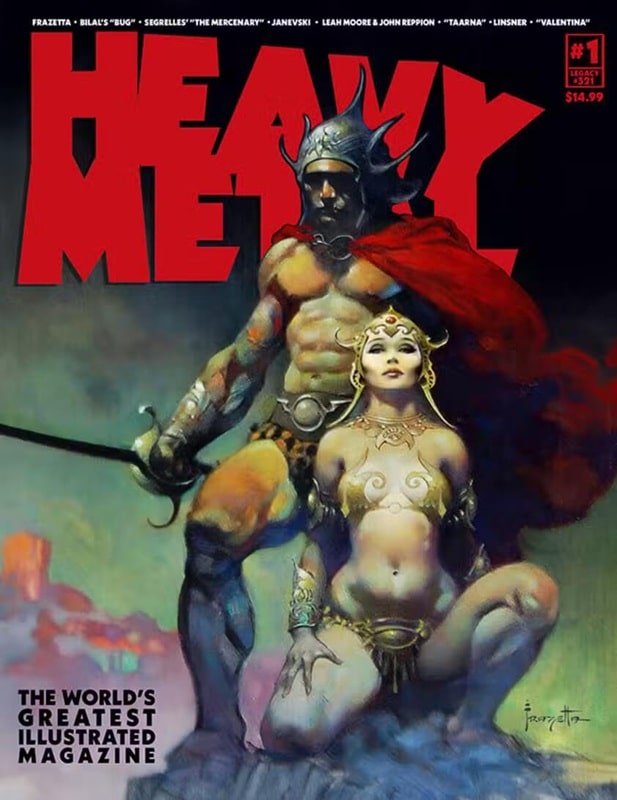 Heavy Metal #1, Sword & Sorcery variant (April 30, 2025). Cover by Frazetta.
Heavy Metal #1, Sword & Sorcery variant (April 30, 2025). Cover by Frazetta.
Financial struggles loomed, leading to a partnership with Whatnot Publishing in 2022 to produce future issues. However, cash flow problems forced Heavy Metal to cease publication in December 2022, ending its continuous run since 1977. Despite efforts to revive operations and fulfill obligations, only one additional issue was produced, and the magazine was officially canceled in mid-2023.
Which brings us to today.
In October 2024, Heavy Metal International, LLC announced a relaunch planned for 2025, backed by a Kickstarter campaign to fund it. The campaign had a modest $5000 goal but nearly 11,000 fans proceeded to blow that right out of the water and contributed a whopping $781K. HMI put together this short video announcing the comeback of the magazine so check it.
Heavy Metal magazine (new) issue 1 is set to drop in April in stores, and the magazine’s website indicates that subscriptions to the new version will be available there soon. I’m definitely going to give this a look when it hits shelves to see if Heavy Metal was a point in time, or if it can be successful in this era.
Thoughts?
Comment on Worldbuilding Articles: Reader Poll (2025 Edition) by Skeeve
1. Essentia Capacity
2. The Board
3. Sigil Recycling
4. Attunement


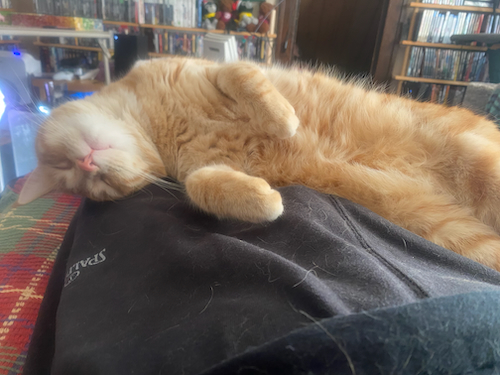



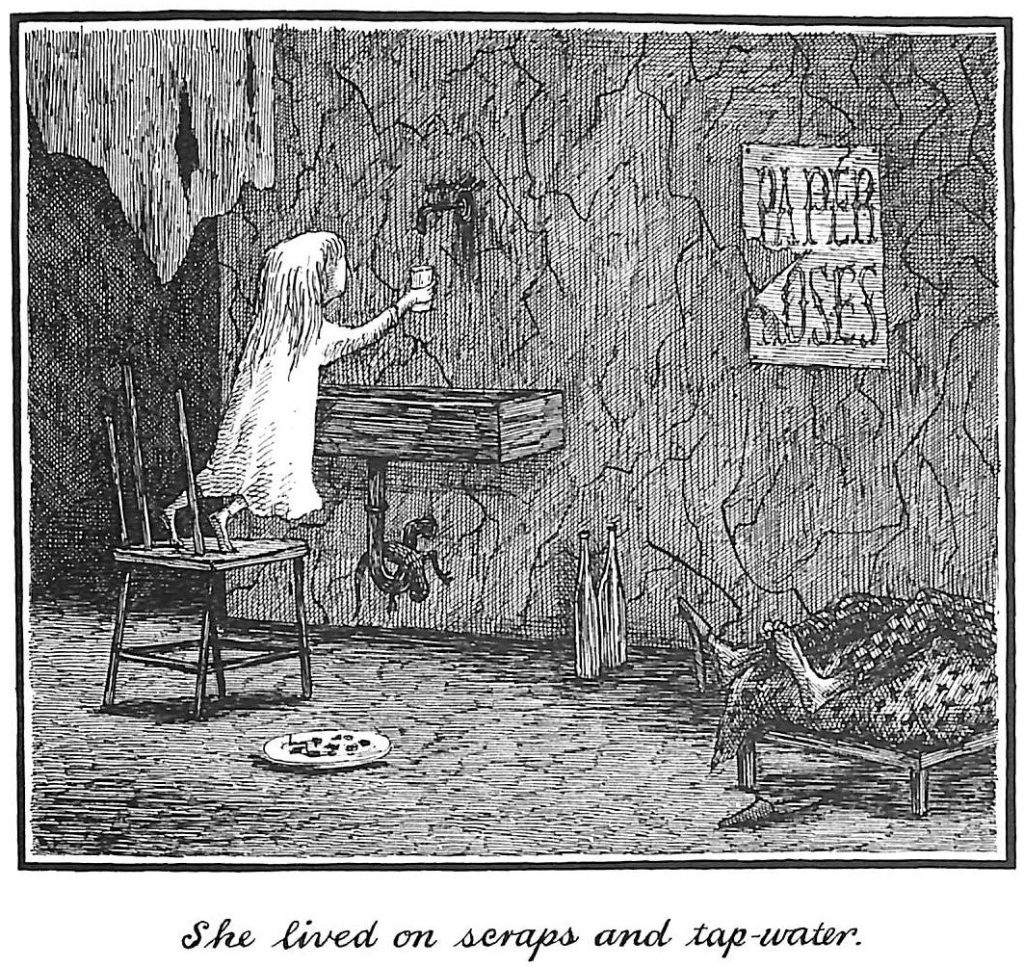
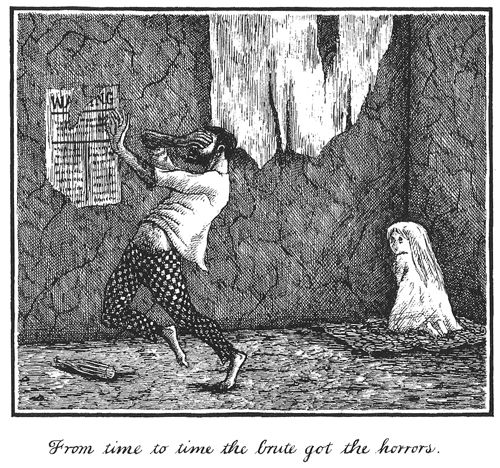
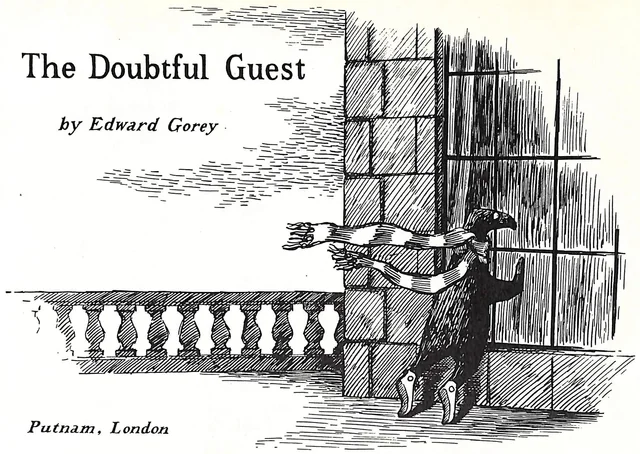
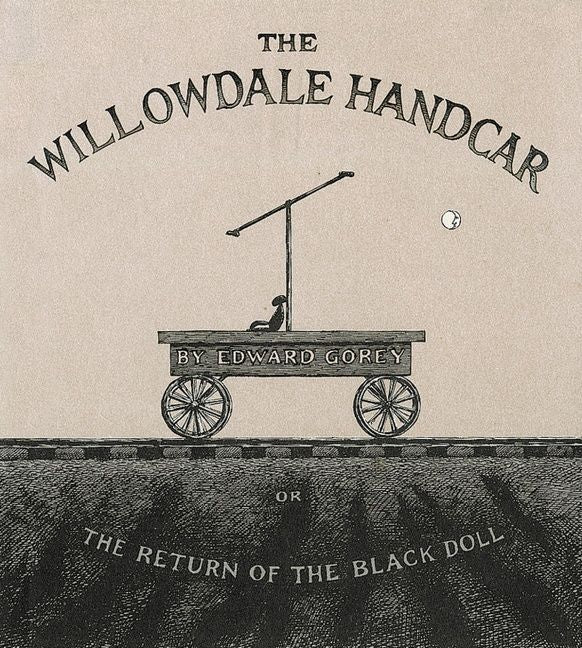

Recent comments